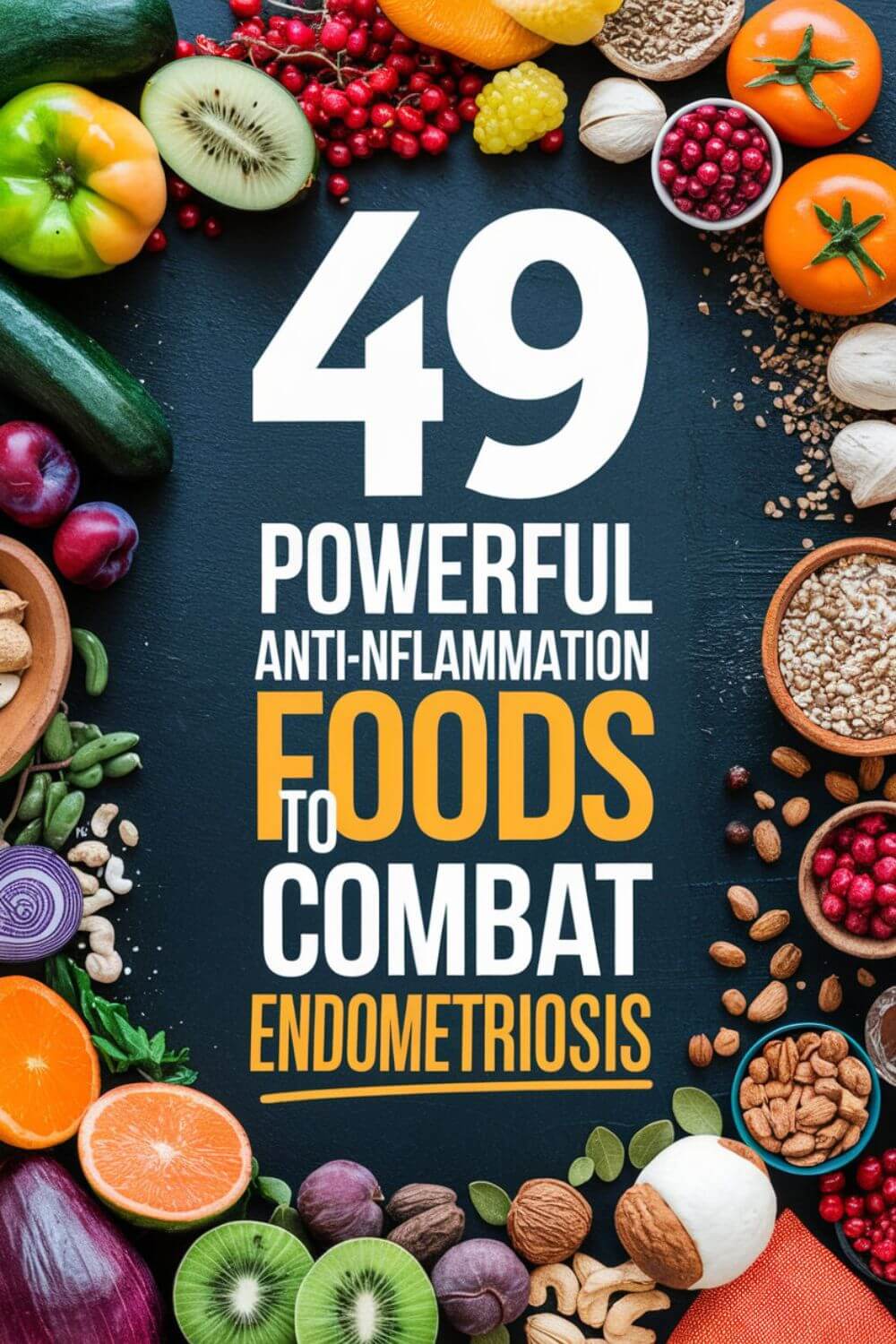49 Powerful Anti-Inflammation Foods to Combat Endometriosis
Have you ever felt like your body is at war with itself, every meal triggering pain and discomfort? Anti-inflammation foods might be the key to breaking free from that cycle and finding relief from the relentless symptoms of endometriosis.
Inflammation plays a central role in endometriosis, worsening pain, fatigue, and digestive issues. An anti-inflammatory diet focuses on nutrient-dense, whole foods that help reduce this inflammation, promoting overall well-being. Studies suggest that avoiding inflammatory triggers while consuming specific foods can ease symptoms and improve daily life for those battling this invisible disease. By making mindful dietary changes, many women with endometriosis have found some measure of relief, regaining a sense of control over their health.
I’ve witnessed firsthand how diet can change everything. My wife, who has battled stage IV endometriosis and fibromyalgia, struggled for years before she understood how food was impacting her body. When she embraced a clean eating lifestyle, I saw her begin to heal—not just physically but emotionally, too.
For those dealing with endometriosis, finding relief can often start at the dinner table. A diet rich in anti-inflammatory foods can play a significant role in managing symptoms and promoting overall well-being. Below, you’ll find a handy list of 49+ foods that can help you reduce inflammation and bring more balance to your body.
Let’s dive into the world of anti-inflammation foods and discover how they can support your body in fighting endometriosis.
- How Anti-Inflammation Foods Can Help Endo?
- Olive Oil for Heart Health
- Ginger's Soothing Properties
- Turmeric's Anti-Inflammatory Power
- Nuts and Seeds for Healthy Fats
- Fatty Fish Rich in Omega-3
- Berries Packed with Antioxidants
- Leafy Greens for Nutrient Density
- Avocados for Healthy Fats
- Beets for Natural Detoxification
- Citrus Fruits for Vitamin C
- Cruciferous Vegetables for Fiber
- Sweet Potatoes for Complex Carbs
- Pineapple's Bromelain Benefits
- Garlic’s Immune Boosting Effects
- Fermented Foods for Gut Health
- Legumes for Plant-Based Protein
- Dark Chocolate’s Flavonoids
- Green Tea for Antioxidants
- Mushrooms' Immune Support
- Chia Seeds for Omega-3
- Cinnamon's Anti-Inflammatory Effects
- Tomatoes for Lycopene
- Coconut Oil for Healthy Cooking
- Apples for Fiber and Antioxidants
- Quinoa for Complete Protein
- Pumpkin Seeds for Nutrients
- Whole Grains for Balanced Energy
- Red Grapes for Resveratrol
- Cabbage for High Fiber Content
- Kefir for Probiotics
- Broccoli Sprouts for Nutritional Boost
- Fermented Soy Products for Nutrients
- Miso for Flavor and Probiotics
- Green Apples for Low Sugar Option
- Hemp Seeds for Protein and Omega-3
- Carrots for Beta-Carotene
- Artichokes for Antioxidants
- Nut Butters for Healthy Spreads
- Lentils for Rich Protein Source
- Pomegranate for Antioxidant Boost
- Sweet Peppers for Color and Flavor
- Rhubarb for Vitamin K
- Cabbage for Versatile Cooking
- Wild Rice for Nutty Flavor
- Squash for Nutrient Variety
- Sardines for Omega-3 Richness
- Cacao Nibs for Dark Chocolate Flavor
- Leafy Greens and Their Healing Power
- Turmeric and Ginger Benefits
- Best Anti-Inflammation Foods for Endometriosis
- How I Helped My Wife Heal with Anti-Inflammation Foods
- Final Word on Anti-Inflammation Foods
How Anti-Inflammation Foods Can Help Endo?
Endometriosis is more than just pelvic pain—it’s an all-encompassing condition that affects energy levels, digestion, mood, and even relationships. One of the biggest culprits behind these symptoms is chronic inflammation, which fuels the growth of endometrial-like tissue outside the uterus. Managing inflammation isn’t just about taking medication—it’s about what you put on your plate every single day.
The foods you eat can either aggravate endo symptoms or help calm the storm inside your body. Anti-inflammation foods contain compounds that help reduce oxidative stress, balance hormones, and support gut health—all of which play a crucial role in managing this condition.
For years, my wife suffered from what she called “endo flares.” She would go from functioning normally to being curled up in agony, her stomach bloated like she was six months pregnant—what many call the infamous endo belly. At first, we didn’t understand what was happening. But the more we researched, the clearer it became: food was a trigger.
When she started focusing on nutrient-dense, anti-inflammatory meals, the change was undeniable. Her pain episodes became less frequent, her energy improved, and her mental clarity returned. It wasn’t a cure, but it gave her power over a body that had felt like an enemy for years.
A well-structured anti inflammation diet is more than just a list of “good” and “bad” foods—it’s a way to reclaim control. It involves removing processed foods, added sugars, and inflammatory oils while embracing foods that fight inflammation, support digestion, and promote healing.
If you want to dive deeper into how dietary changes can transform your experience with endometriosis, I invite you to check out the FREE chapter of my book, “Endo-Tool: Endometriosis for Men.” Not only do I share essential insights, but I also offer personal stories, emotional support, and practical guidance for both men and women navigating this journey.
The first chapter alone contains all the comprehensive medical knowledge about endometriosis, including:
The first chapter alone contains all the comprehensive medical knowledge about endometriosis, including:
- What is endometriosis?
- What are the symptoms?
- What causes endometriosis?
- What does endometriosis look like?
- What are the stages?
- What are the types?
- What is adenomyosis and how is it related to endometriosis?
- Why do some women develop severe endo and others don’t?
- Does endometriosis cause infertility?
- How is endometriosis diagnosed?
- Do types and stages affect the treatment?
- Recurrence of endometriosis after excision surgery.
FREE Chapter of “Endo-Tool”
Endometriosis e-Book for Men
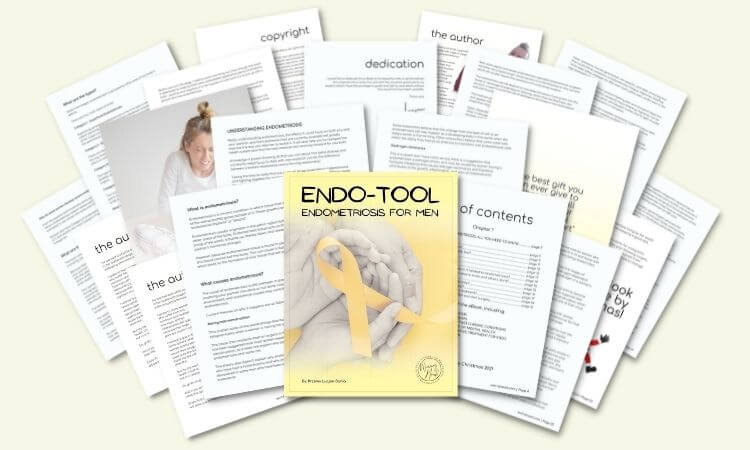
Olive Oil for Heart Health

Olive oil is a staple in many kitchens, and for good reason. This beautiful bottle, with its rich green hue, is packed with health benefits. Not only does it add flavor to your meals, but it also plays a role in heart health.
Rich in monounsaturated fats, olive oil is known to help lower bad cholesterol levels. It’s a great choice for those following an anti inflammation diet. Incorporating it into your meals can be easy, whether you’re drizzling it on a salad or using it in your favorite healthy lunch recipes.
This oil is also part of the Mediterranean diet, which emphasizes whole foods and non inflammatory foods. For anyone on a low FODMAP diet, olive oil can be a fantastic addition. It pairs well with many low FODMAP vegetables and can elevate simple dishes into something special.
If you’re looking for easy low FODMAP recipes, try mixing olive oil with lemon juice and herbs for a simple dressing. This can turn a basic salad into a nutritious meal that helps reduce inflammation fast.
Ginger’s Soothing Properties
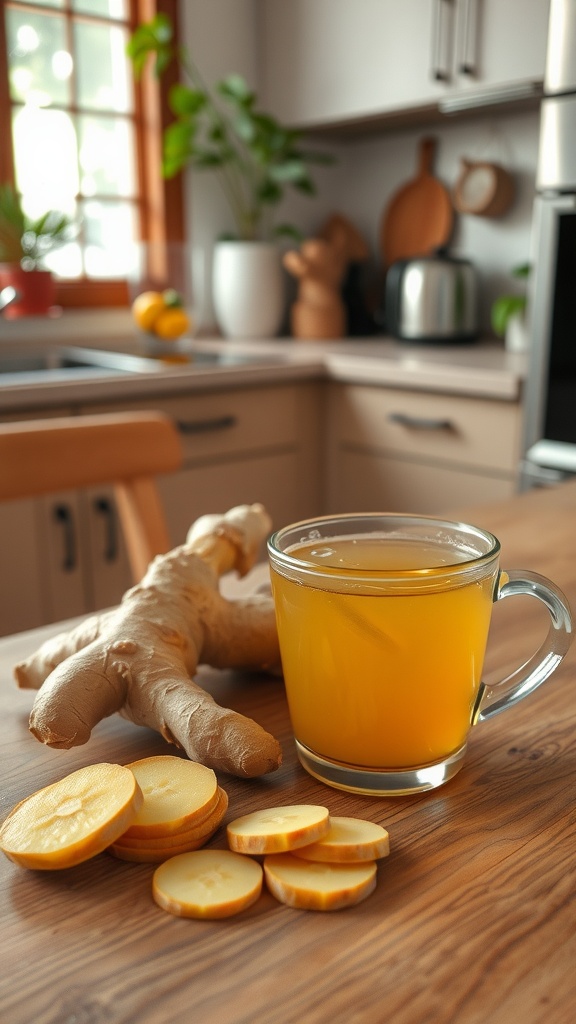
Ginger is a fantastic addition to your diet, especially if you’re looking for anti inflammation foods. This root has been used for ages in traditional medicine. It’s known for its ability to reduce inflammation, making it a great choice for those dealing with conditions like endometriosis.
In the image, we see fresh ginger root alongside slices and a warm glass of ginger tea. This visual perfectly captures how simple it is to incorporate ginger into your daily routine. A cup of ginger tea can be a soothing anti inflammation breakfast or a comforting evening drink.
For those on a low FODMAP diet, ginger is a friendly ingredient. You can easily whip up easy low FODMAP recipes by adding ginger to smoothies or stir-fries. It pairs well with various low FODMAP vegetables, enhancing flavor while also providing health benefits.
Not only does ginger help with inflammation, but it also supports digestion, making it an excellent choice for anyone following an IBS diet food list. So, if you’re looking to reduce inflammation fast, consider reaching for ginger in your anti inflammation meal plan.
Turmeric’s Anti-Inflammatory Power
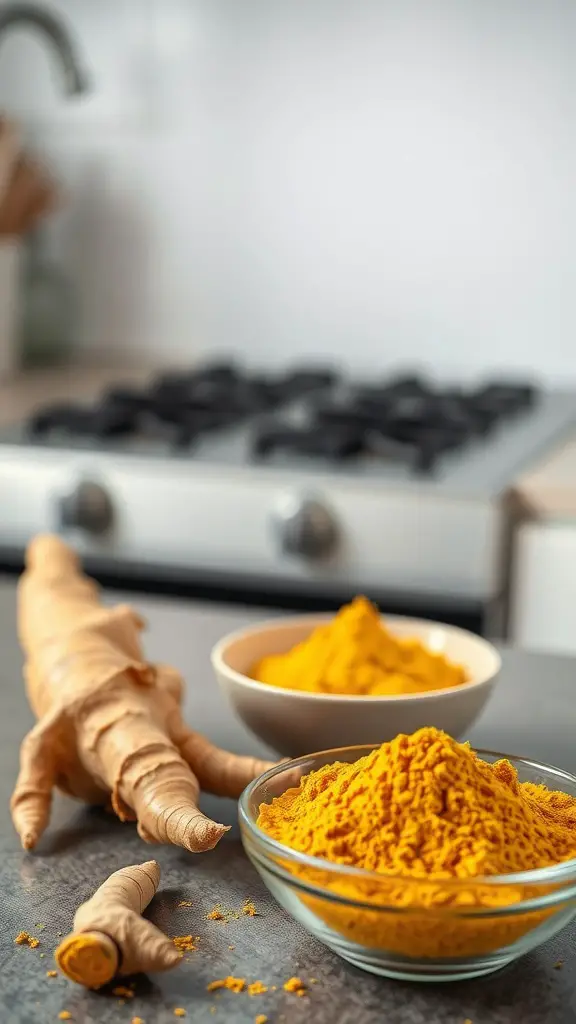
Turmeric is a spice that has gained popularity for its impressive anti-inflammatory properties. In the image, you can see fresh turmeric root alongside turmeric powder, which is often used in cooking. This bright yellow spice not only adds flavor but also has health benefits that many people appreciate.
For those following a low FODMAP diet, turmeric can be a fantastic addition. It’s considered IBS-friendly and can easily fit into your low FODMAP meal prep. You can sprinkle it on roasted low FODMAP vegetables or incorporate it into anti-inflammation meal plans.
Curcumin, the active ingredient in turmeric, plays a significant role in reducing chronic inflammation. This is key for individuals dealing with conditions like endometriosis. Adding turmeric to your anti inflammation recipes meals can help you manage symptoms better.
Whether you’re looking for easy low FODMAP recipes or searching for non inflammatory foods, turmeric can be a go-to ingredient. It pairs well with various dishes, making it versatile for both anti inflammation breakfast and lunch ideas. So, why not give turmeric a try in your next healthy lunch recipe?
Nuts and Seeds for Healthy Fats
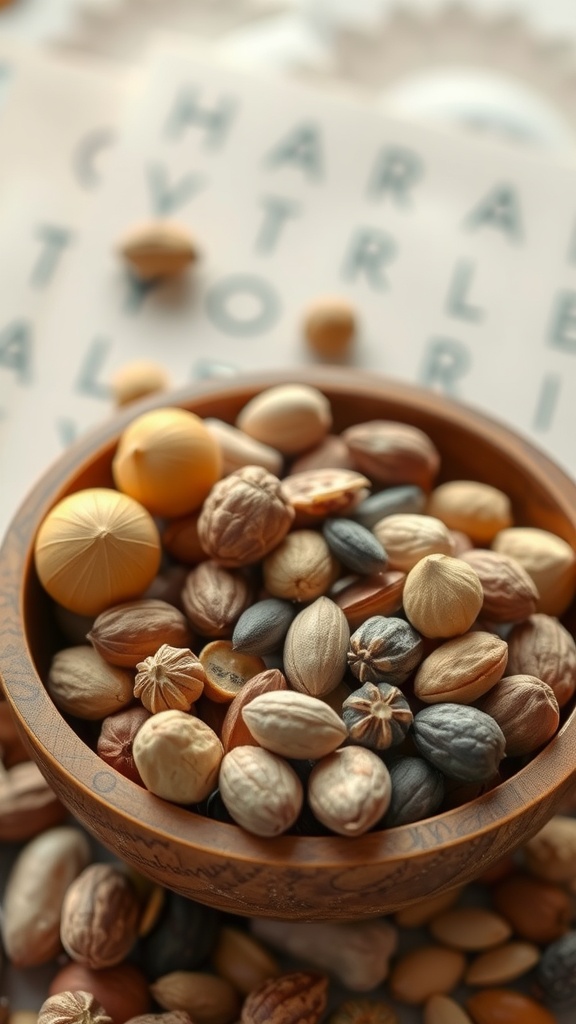
Nuts and seeds are fantastic sources of healthy fats. They not only add flavor to meals but also provide essential nutrients. When you’re looking to reduce inflammation, incorporating these foods is a smart choice. They contain omega-3 fatty acids, which are known to help combat chronic inflammation.
The image shows a beautiful wooden bowl filled with a variety of nuts and seeds. From almonds to sunflower seeds, each one offers unique health benefits. Snacking on these can serve as anti inflammation snacks, keeping you satisfied and nourished.
For those following a low fodmap diet, many nuts and seeds fit right in. They can be enjoyed as part of easy low fodmap recipes or as simple low fodmap snacks throughout the day. Just a handful can make a delightful addition to your meals.
Whether you sprinkle them over salads or mix them into smoothies, nuts and seeds are versatile. They can be a key part of your anti inflammation meal plan. Plus, they’re an easy way to add texture and taste without compromising on health.
Fatty Fish Rich in Omega-3
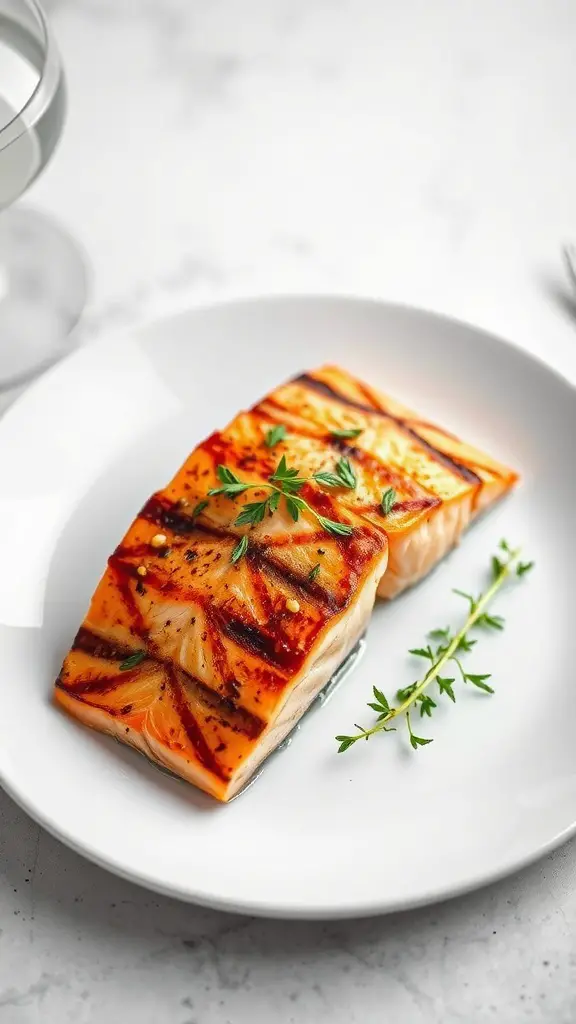
Fatty fish like salmon, mackerel, and sardines are fantastic choices for those looking to tackle inflammation. These fish are loaded with omega-3 fatty acids, which have been shown to help reduce inflammation in the body. They can be a key part of an anti inflammation meal plan, especially if you’re managing conditions like endometriosis.
The image shows a beautifully grilled salmon filet, garnished with fresh herbs. This dish not only looks appealing but also packs a healthy punch. Eating fish like this can fit well into a low FODMAP meal plan, making it easier for those with sensitive digestion to enjoy. Pairing it with low FODMAP vegetables can create a balanced, antiinflammatory meal.
Incorporating fatty fish into your diet doesn’t have to be complicated. You can try easy low FODMAP recipes that include baked or grilled fish, which can be seasoned simply with herbs and spices. This way, you get to enjoy the health benefits without overwhelming your taste buds. Aim for a few servings per week to really reap the benefits of these non inflammatory foods.
Berries Packed with Antioxidants
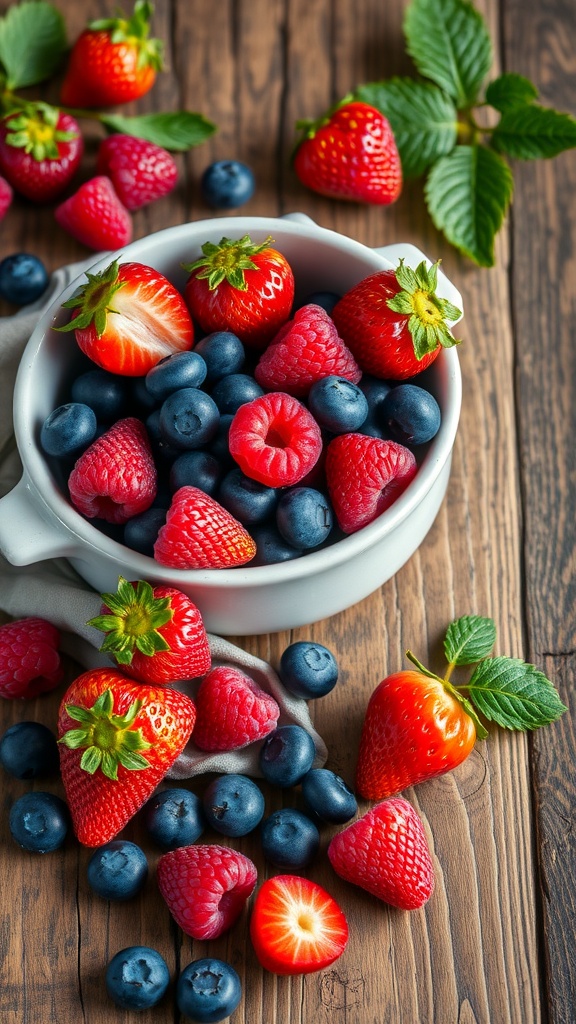
Berries like strawberries, blueberries, and raspberries are colorful and delicious, making them a perfect addition to an anti inflammation diet. These fruits are loaded with antioxidants, which help combat chronic inflammation in the body.
Incorporating berries into your meals can be simple. You can toss them into smoothies for an anti inflammation breakfast or sprinkle them on top of yogurt for a healthy lunch. They also make for great low FODMAP snacks, fitting snugly into a low FODMAP meal plan.
When aiming to reduce inflammation fast, think of easy low FODMAP recipes that highlight these fruits. You can create berry salads or mix them into overnight oats. They are not just tasty; they are also part of a clean eating lifestyle that fuels your body with non inflammatory foods.
If you’re exploring anti inflammation meal plans, consider how versatile berries are. They can be a sweet component in anti inflammation recipes meals, providing natural sweetness without added sugars. From smoothies to toppings, the possibilities are endless!
Leafy Greens for Nutrient Density
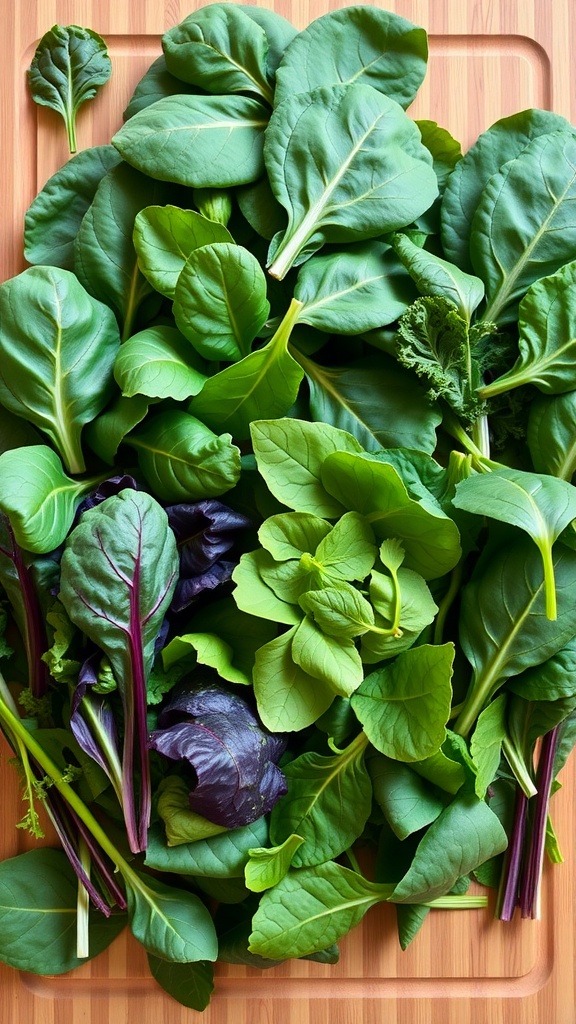
Leafy greens are powerhouses of nutrition, especially when it comes to managing conditions like endometriosis. The vibrant greens in the image showcase a variety of options, including spinach, kale, and Swiss chard. Each type brings its own unique set of vitamins and minerals that help boost overall health.
Incorporating these greens into your meals can help reduce chronic inflammation. They are low in calories but high in essential nutrients, making them perfect for anyone looking to follow a low FODMAP meal plan. Whether you’re aiming for anti-inflammatory snacks or planning an anti-inflammatory breakfast, leafy greens can easily fit in.
For those dealing with IBS or other digestive issues, leafy greens are often IBS-friendly foods, providing fiber without causing discomfort. You can mix them into salads, smoothies, or even soups. If you’re searching for easy low FODMAP recipes, try sautéing kale with olive oil and garlic for a quick side dish.
These greens also work well in low FODMAP lunch ideas. A simple spinach salad topped with grilled chicken and a light vinaigrette makes for a delicious, nutrient-dense meal. Remember, non-inflammatory foods like these are key players in an inflammation diet for beginners. So, load up on greens and enjoy the benefits!
Avocados for Healthy Fats
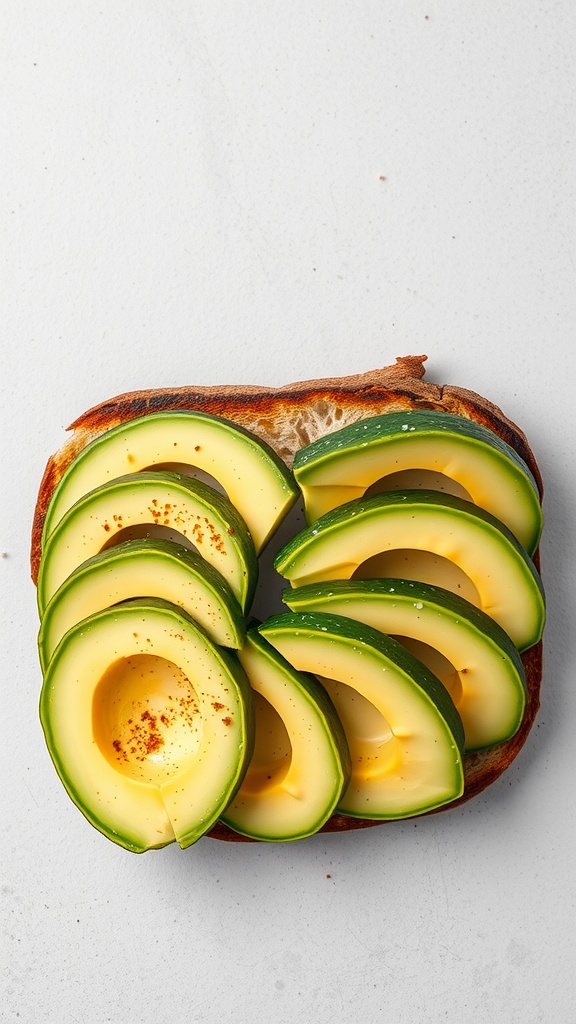
Avocados are a fantastic addition to an anti-inflammation diet. They are rich in healthy fats, particularly monounsaturated fats, which are known to help reduce inflammation in the body. This creamy fruit is a tasty way to boost your meals while supporting your health.
The image shows perfectly sliced avocado on toast, showcasing its vibrant green color. This dish is simple yet packed with nutrients. You can easily make a quick anti inflammation breakfast by spreading mashed avocado on whole grain or gluten-free bread. Add a sprinkle of salt or chili flakes for extra flavor.
Incorporating avocados into your meals is easy. Whether you toss them in a salad, blend them into smoothies, or use them as a spread, they can fit into various anti inflammation recipes. They also fit well with a low FODMAP meal plan, making them suitable for those with digestive concerns.
Start your day with an avocado toast topped with some tomatoes or an afternoon snack with avocado slices and whole grain crackers. These healthy options are non inflammatory foods that help fight chronic inflammation.
Beets for Natural Detoxification
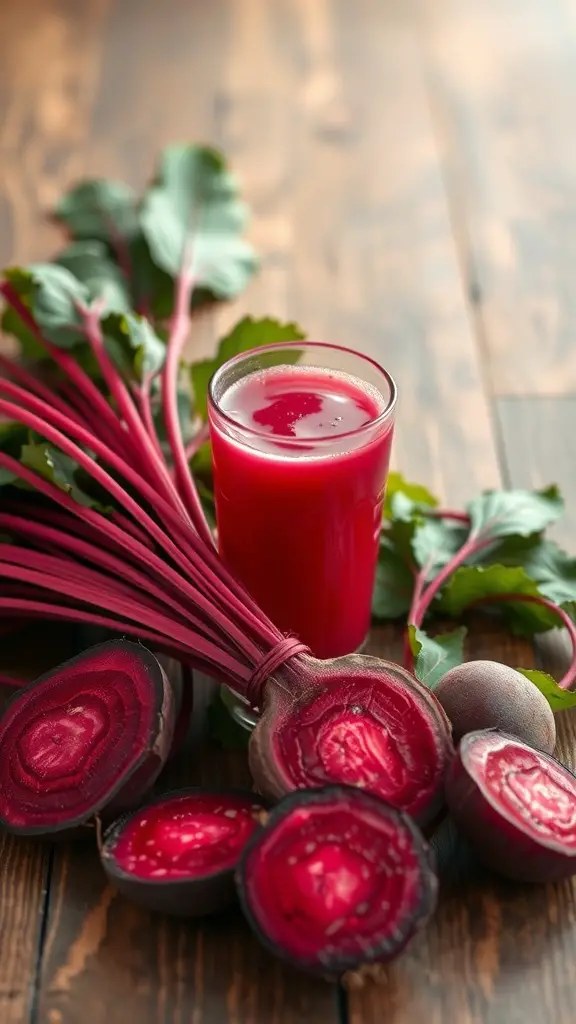
Beets are a vibrant root vegetable known for their deep red color and earthy flavor. The image shows fresh beets alongside a glass of beet juice, highlighting their natural appeal.
Including beets in your diet can be a fantastic choice for managing inflammation. They are packed with antioxidants and anti-inflammatory properties, making them ideal for an inflammation diet for beginners.
These little gems can easily fit into an anti inflammation meal plan. You can enjoy them roasted, in salads, or as a refreshing juice. They’re also great for clean eating, providing a healthy dose of nutrients without any added sugars.
If you’re following a low FODMAP diet, beets are a safe option. They are low in fermentable carbs, making them IBS-friendly. This makes them a perfect addition to your low FODMAP meal prep and healthy lunch recipes.
For those looking to reduce inflammation fast, consider adding beets to your anti inflammation snacks. You can blend them into smoothies or pair them with hummus for a tasty treat. Their versatility makes them a favorite among antiinflammatory meals.
So, whether you’re enjoying a glass of beet juice or incorporating them into your low FODMAP recipes breakfast, beets can support your journey towards better health.
Citrus Fruits for Vitamin C

Citrus fruits are a fantastic addition to your anti-inflammation meal plan. They are packed with vitamin C, which plays a key role in reducing chronic inflammation. The vibrant colors of oranges, lemons, and grapefruits not only brighten your plate but also provide essential nutrients that help your body fight inflammation.
These fruits can be easily integrated into your daily eating routine. Consider adding slices of orange or lemon to your water or using them in low FODMAP recipes for breakfast. They also make for refreshing anti-inflammation snacks that satisfy your sweet tooth while supporting your health.
If you’re looking for easy low FODMAP recipes, a citrus salad can be a delightful choice. Just mix up some orange segments, grapefruit, and a sprinkle of mint for a fresh dish. This is a simple way to enjoy foods that help with inflammation while sticking to clean eating principles.
Cruciferous Vegetables for Fiber
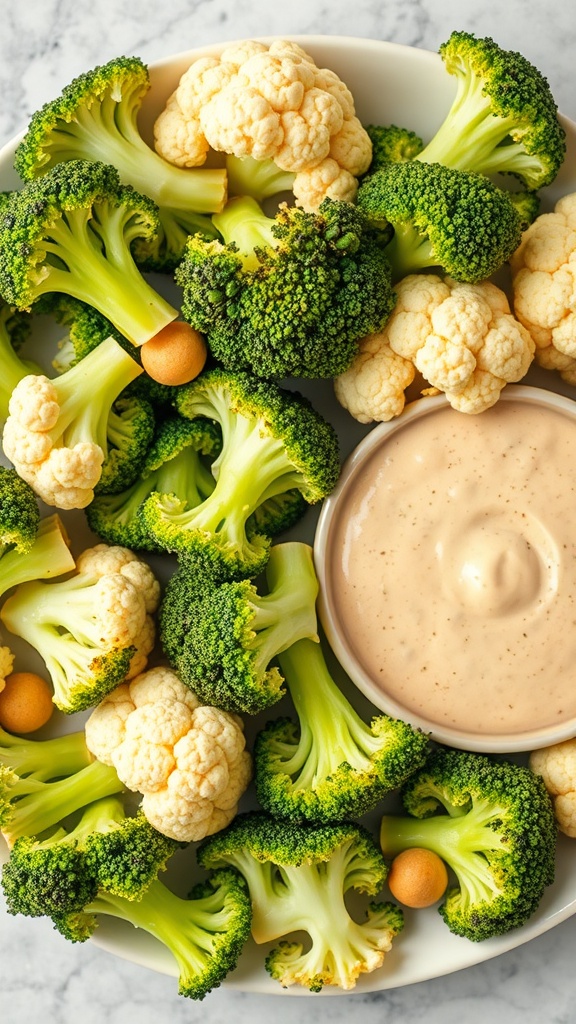
When we talk about anti-inflammation foods, cruciferous vegetables are at the top of the list. The image showcases a vibrant plate of broccoli and cauliflower. These veggies not only look fresh and appealing but are also packed with nutrients.
Cruciferous vegetables like broccoli and cauliflower are excellent sources of fiber. Fiber plays a key role in digestion and can help reduce chronic inflammation. If you’re starting with a low FODMAP diet, these veggies are a great choice as they are low in fermentable sugars.
Including these in your meals is simple. You can munch on them raw with a dip or steam them lightly for a side dish. They fit perfectly into healthy lunch recipes or can be added to your anti inflammation meal plan.
For a quick snack, consider a low FODMAP recipe using these veggies. They can be tossed in olive oil, sprinkled with some salt, and roasted for a delicious treat. Whether you’re looking for anti inflammation snacks or easy low FODMAP recipes, cruciferous vegetables should definitely be on your plate!
Sweet Potatoes for Complex Carbs
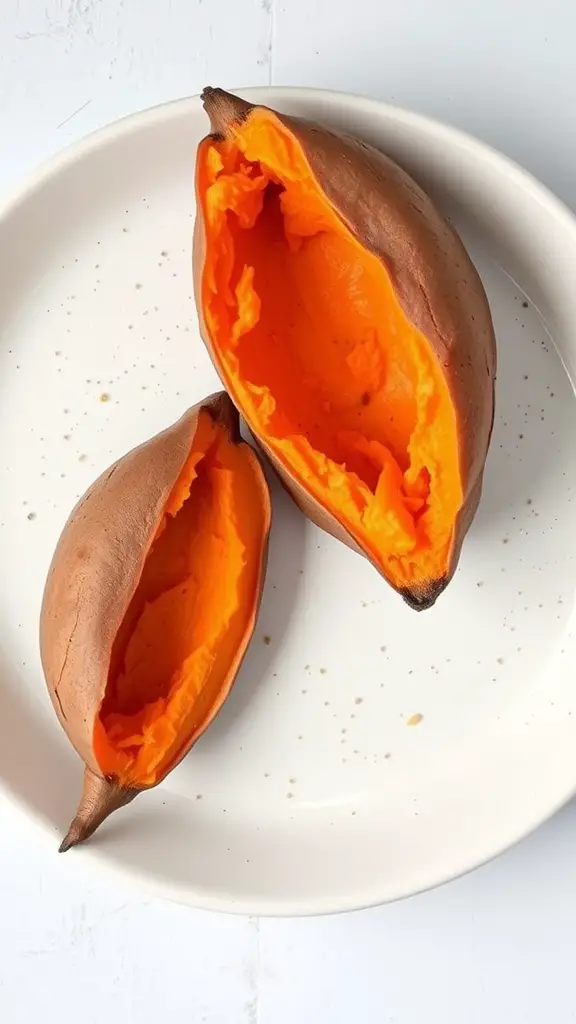
Sweet potatoes are not just vibrant and tasty; they are also a fantastic addition to an anti-inflammation diet. This image shows beautifully cooked sweet potatoes, revealing their bright orange flesh. This color indicates they are high in beta-carotene, which is known for its anti-inflammatory properties.
Incorporating sweet potatoes into your meals can help reduce inflammation fast. They are complex carbs, providing steady energy without spiking blood sugar levels. This is particularly beneficial for anyone following a low FODMAP diet, as sweet potatoes are IBS-friendly foods that many people can enjoy without discomfort.
Try them roasted, mashed, or even as part of salads. You can create easy low FODMAP recipes with sweet potatoes by adding them alongside lean proteins or leafy greens. They also fit perfectly into an anti-inflammation meal plan, making them a versatile ingredient for healthy lunch recipes or even anti-inflammation breakfast ideas.
Pineapple’s Bromelain Benefits

Pineapple is not just a delicious tropical fruit; it’s packed with health benefits, especially for those looking to reduce inflammation. One of its standout features is bromelain, an enzyme that helps break down proteins and can ease inflammation in the body.
Incorporating pineapple into your diet can be a flavorful way to support an anti inflammation meal plan. Whether you enjoy it fresh, in smoothies, or as part of anti inflammation recipes meals, its natural sweetness is a bonus. Plus, it fits well into low fodmap meal plans, making it a great option for those following specific dietary guidelines.
Pineapple is also a fantastic addition to anti inflammation snacks. You can slice it up for a quick bite or mix it into a healthy lunch recipe. Its juicy texture and sweet taste can make a simple dish feel more exciting.
When considering foods for inflammation, pineapple stands out for its unique benefits. It’s low in calories and high in vitamins, making it a great choice for clean eating. If you’re exploring the fodmap diet for beginners, you’ll find low fodmap recipes breakfast ideas featuring pineapple that are refreshing and easy to prepare.
So next time you’re planning your anti inflammation diet, think about adding this vibrant fruit to your grocery list. It’s a tasty way to help reduce inflammation fast!
Garlic’s Immune Boosting Effects
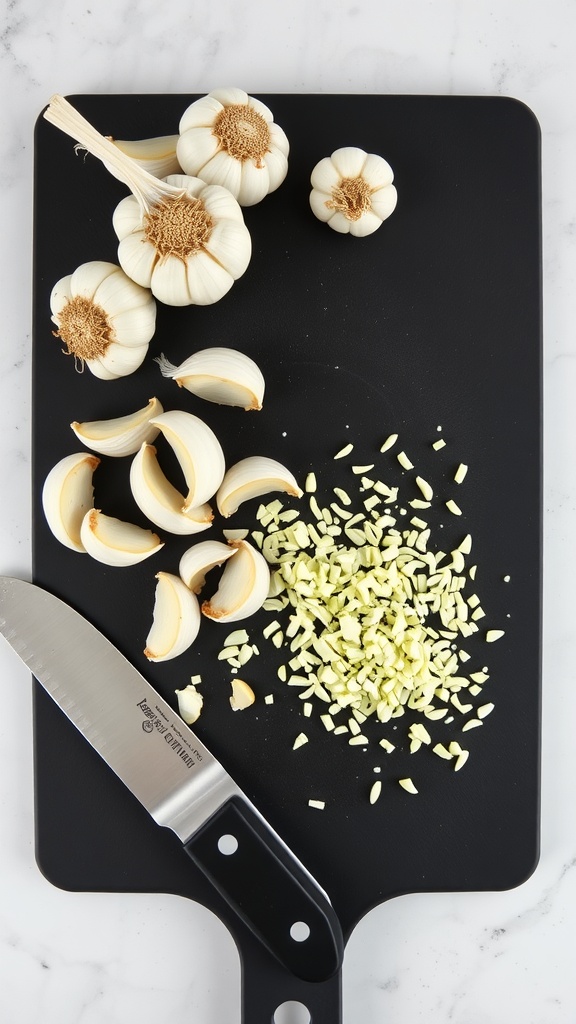
Garlic is not just a flavorful ingredient; it’s a powerhouse for your immune system. The image shows fresh garlic, sliced and ready to use. This bulb is rich in compounds that help reduce inflammation, making it perfect for anyone looking to enhance their anti inflammation meal plan.
When you include garlic in your meals, you’re adding more than taste. Garlic contains allicin, which has been shown to have anti-inflammatory properties. This makes it one of the top foods for inflammation, especially beneficial for those managing chronic inflammation.
There are many ways to incorporate garlic into your diet. You can use it in healthy lunch recipes, anti inflammation snacks, or even in low fodmap meals. Whether roasted, sautéed, or raw, garlic fits perfectly into an anti inflammation diet. It adds flavor to dishes while also being a non inflammatory food, which is ideal for your health.
Consider garlic in your anti inflammation recipes meals. Simply minced garlic added to olive oil makes a great base for dressings or marinades. Or try adding it to your low fodmap meal prep to boost the flavor without adding unnecessary ingredients.
Overall, garlic is an easy addition to any meal. Whether you’re whipping up anti inflammatory breakfast options or looking for low fodmap lunch ideas, garlic can be your go-to ingredient.
Fermented Foods for Gut Health
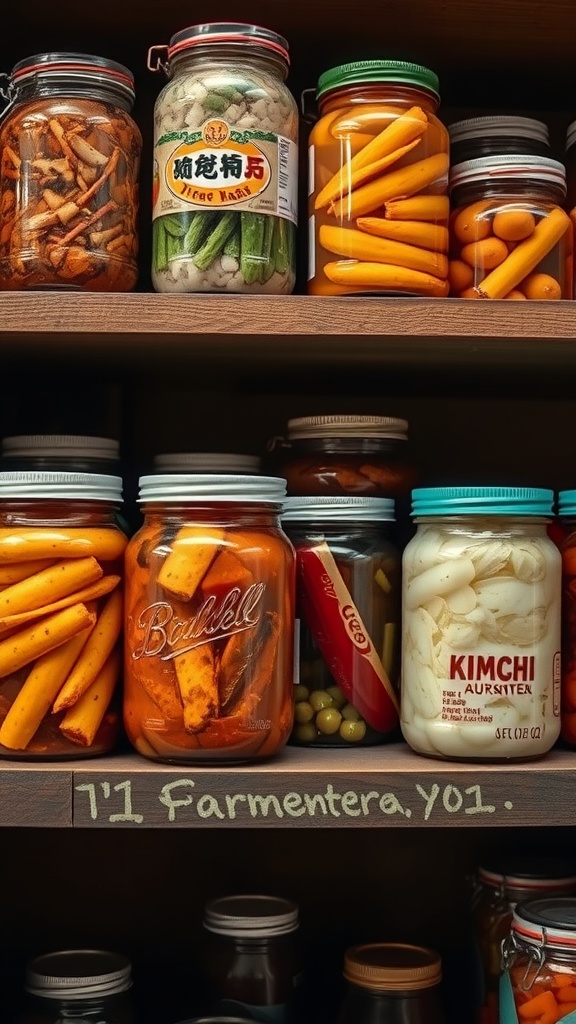
Fermented foods are a fantastic addition to your diet, especially for those managing endometriosis. They can promote gut health and reduce inflammation. The image shows a variety of colorful jars filled with fermented goodies, like kimchi and pickled vegetables. These foods are packed with probiotics that support a healthy gut, which is essential for reducing chronic inflammation.
Incorporating fermented foods into your meals can be simple. You can include them in healthy lunch recipes or anti-inflammatory meals. Think about adding kimchi to a rice bowl or enjoying some pickled carrots as an easy low FODMAP snack. Fermented foods also fit well into a low FODMAP diet, helping you manage symptoms while still enjoying tasty meals.
For those on a low FODMAP meal plan, these foods are great for adding flavor without triggering your IBS symptoms. Consider including them in your anti inflammation diet recipes. Not only do they taste good, but they also help with inflammation and overall gut health.
Legumes for Plant-Based Protein
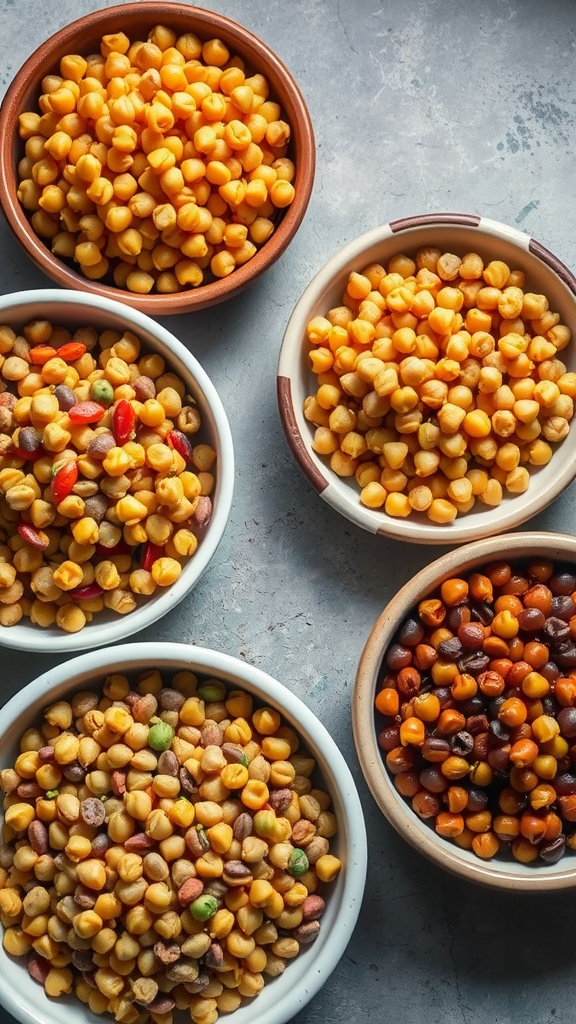
Legumes are a fantastic addition to any anti-inflammation diet. They offer a wealth of plant-based protein and are packed with fiber, making them perfect for gut health. In the image, we see colorful legumes displayed in different bowls, highlighting their variety and appealing textures.
Including legumes in your meals can help you create delicious antiinflammatory meals. They’re low in fat and high in nutrients, which is a great combination for reducing inflammation fast. This makes them a staple in the inflammation diet for beginners.
Some popular legumes to consider are lentils, chickpeas, and black beans. These can easily fit into a low FODMAP food list, which is valuable for those following an IBS diet. You can enjoy them in salads, soups, or even as a base for healthy lunch recipes.
If you’re looking for easy low FODMAP recipes, try a chickpea salad with olive oil, lemon, and your favorite low FODMAP vegetables. It’s quick and packed with nutrients. Remember, legumes are not only filling but also contribute to maintaining a balanced anti inflammation meal plan.
Dark Chocolate’s Flavonoids
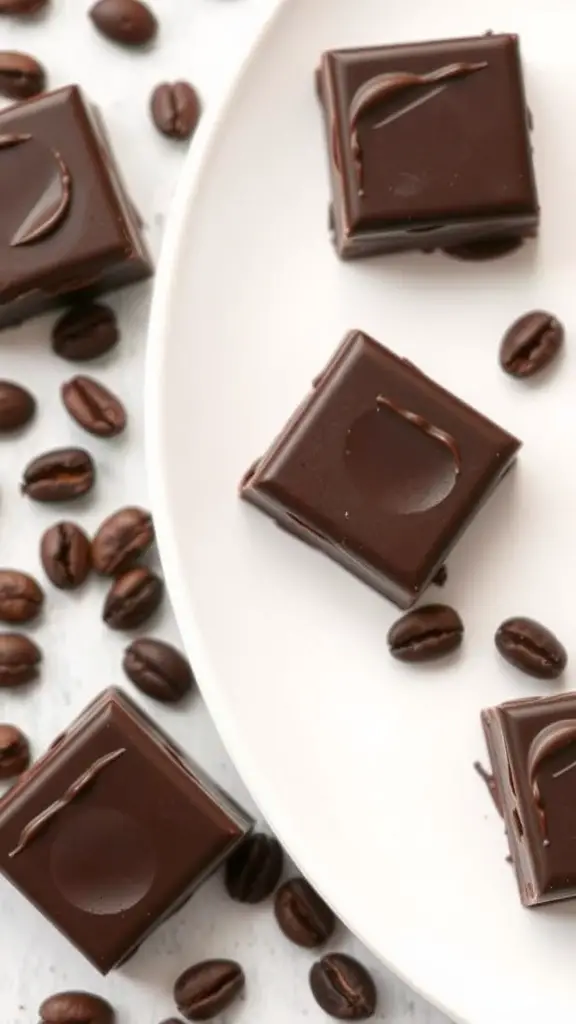
Dark chocolate is not just a sweet treat; it’s packed with health benefits too! The image shows rich, dark chocolate squares arranged neatly on a plate, surrounded by coffee beans. This delightful combination highlights how versatile dark chocolate can be.
The flavonoids found in dark chocolate are powerful antioxidants that can help reduce inflammation. For anyone dealing with chronic inflammation, incorporating dark chocolate into your diet can be a delicious way to support your health.
When looking for anti inflammation foods, dark chocolate should definitely be on your list. It’s a non inflammatory food that can be enjoyed as an anti inflammation snack or even as part of an anti inflammation meal plan. Just remember to choose chocolate with at least 70% cocoa to maximize those health benefits!
If you’re considering low FODMAP options, dark chocolate can fit right in with low FODMAP meal prep. Pair it with some low FODMAP fruit or nuts for a tasty and healthy treat. This way, you can enjoy your favorite snacks without compromising your health.
Green Tea for Antioxidants
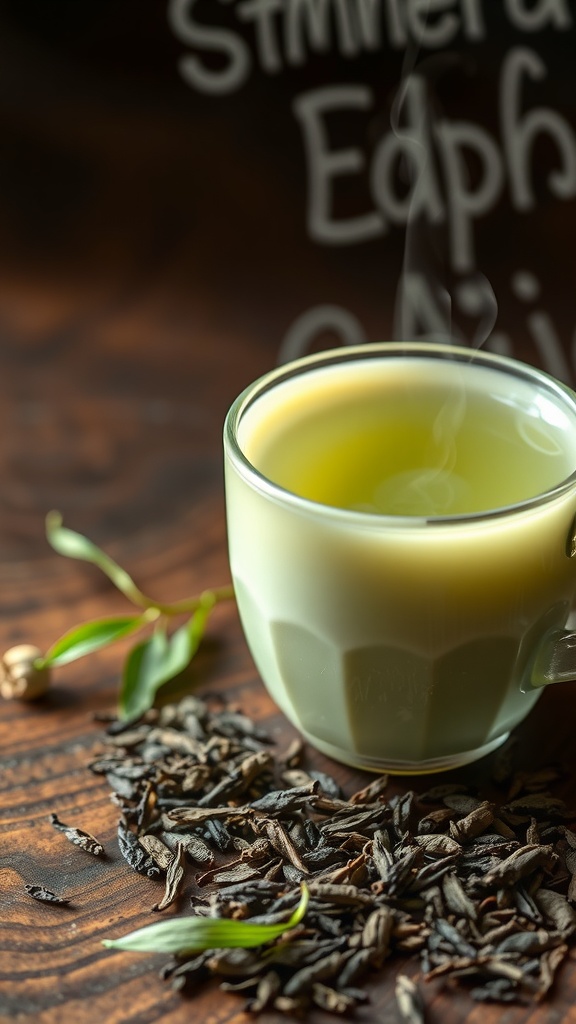
Green tea is a fantastic choice for anyone looking to reduce inflammation. Its rich antioxidant profile makes it a standout in the world of anti-inflammatory foods.
The image captures a steaming cup of green tea, surrounded by loose leaves. This visual not only highlights the beverage’s refreshing appeal but also emphasizes the natural ingredients that contribute to its health benefits.
Green tea is known for catechins, a type of antioxidant that helps combat chronic inflammation. Incorporating it into your daily routine can be as simple as enjoying a warm cup during your morning break or adding it to your low FODMAP lunch ideas. You might even consider pairing it with anti-inflammation snacks for a healthy boost.
If you’re on a low FODMAP diet, green tea is a safe choice. It fits perfectly into easy low FODMAP recipes or as a refreshing drink alongside your anti-inflammatory meal plan. So, grab a cup of green tea and sip your way to better health!
Mushrooms’ Immune Support
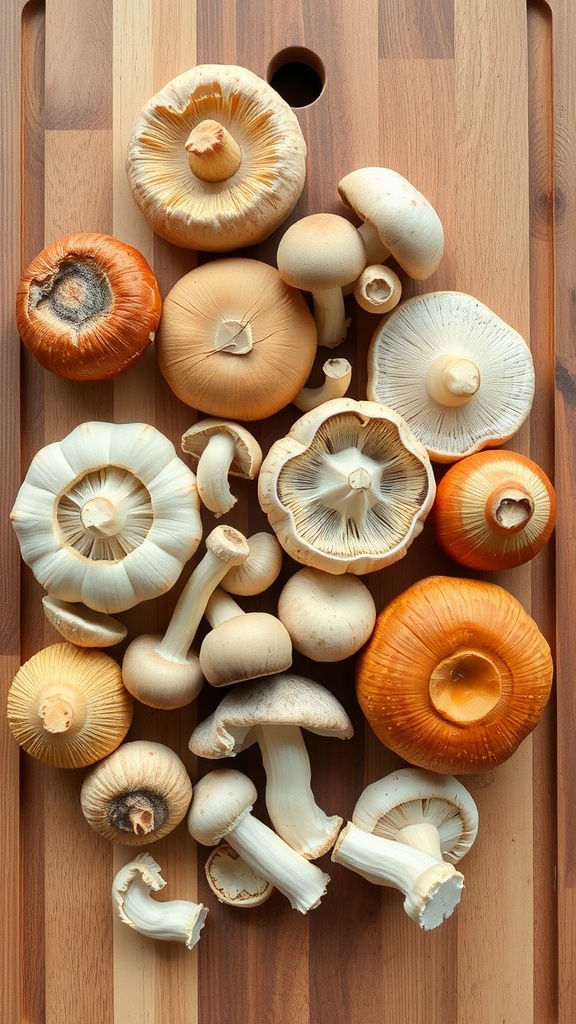
Mushrooms are not just tasty; they’re also packed with health benefits. The array of mushrooms shown in the image highlights their diversity and nutritional value. They come in various shapes and colors, each offering unique properties.
These fungi are considered non-inflammatory foods, making them excellent additions to any anti inflammation meal plan. They contain antioxidants that help combat chronic inflammation, a common issue for those dealing with endometriosis.
Incorporating mushrooms into your daily routine is easy. You can toss them in salads, soups, or stir-fries. For a quick meal, try easy low fodmap recipes like a mushroom stir-fry with low fodmap vegetables. This way, you can enjoy delicious flavors while also eating foods that help with inflammation.
For a tasty snack, consider sautéing mushrooms with garlic and herbs. This creates an anti inflammation snack that’s both satisfying and healthy. If you’re following a low fodmap diet, mushrooms can fit in well, as long as you choose the right types.
Chia Seeds for Omega-3
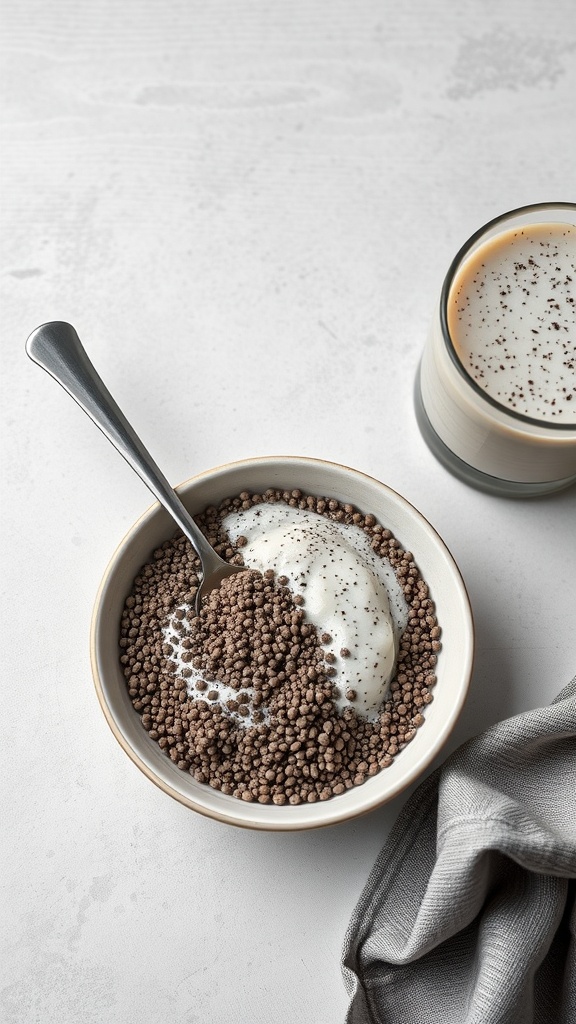
Chia seeds are tiny powerhouses packed with nutrients, especially omega-3 fatty acids. They look like small black and white seeds, and they absorb liquid, which makes them perfect for adding to smoothies or yogurt.
The image shows a bowl filled with chia seeds topped with creamy yogurt and a sprinkle of spices. This combination not only looks appealing but is also a great way to enjoy anti inflammation foods. Pairing chia seeds with yogurt provides a delightful texture and boosts your morning routine.
Incorporating chia seeds into your meals can help create low fodmap easy meals. They are a fantastic addition to an anti inflammation meal plan, too. Whether you’re looking for an anti inflammation breakfast or a quick snack, chia seeds can easily fit into your diet.
Try mixing them into overnight oats or blending them into smoothies for a nutrient boost. If you’re following a low fodmap diet, these seeds can be included in your low fodmap food list. They can help manage chronic inflammation while being friendly for your gut!
Cinnamon’s Anti-Inflammatory Effects
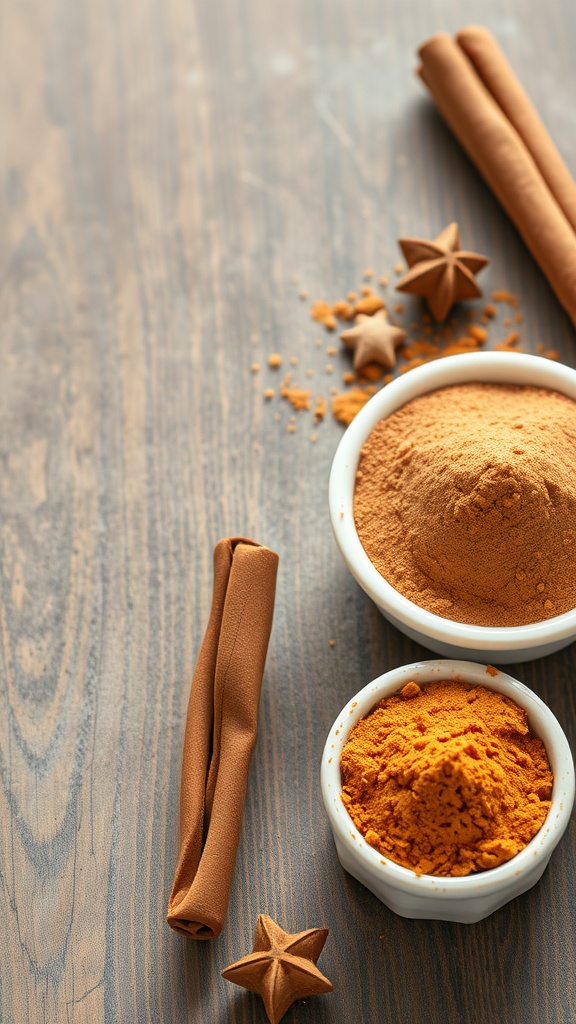
Cinnamon is not just a warm, aromatic spice that adds flavor to your dishes; it’s a powerful ally in the fight against inflammation. The image shows various forms of cinnamon, including ground and stick, highlighting its versatility in cooking.
Incorporating cinnamon into your meals can be a great way to support an anti-inflammatory diet. It’s known to contain antioxidants that help reduce oxidative stress in the body. This is especially important for those dealing with endometriosis, where inflammation plays a significant role.
If you’re following a low FODMAP diet or looking for anti-inflammatory meals, try adding cinnamon to oatmeal or smoothies. It’s a simple way to enhance flavors while promoting health. Also, cinnamon can be a great addition to anti-inflammatory snacks like yogurt or granola. So, don’t hesitate to sprinkle some in your healthy lunch recipes!
For those interested in easy low FODMAP recipes, consider a cinnamon-spiced apple dish. Just slice apples, sprinkle them with cinnamon and bake until tender. This not only tastes delicious but also fits perfectly into an anti inflammation meal plan.
Tomatoes for Lycopene
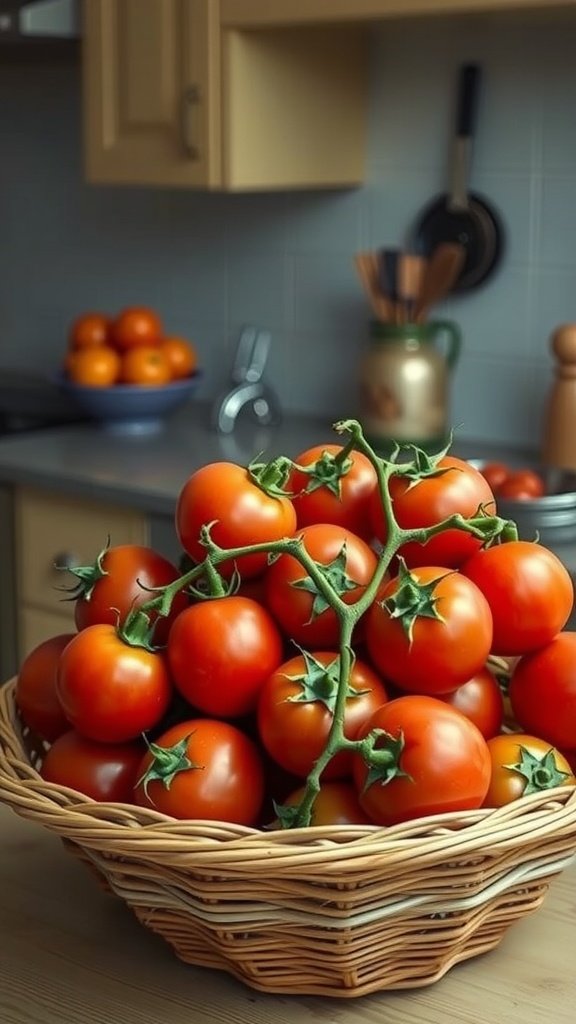
Tomatoes are a delicious and versatile fruit that packs a powerful punch when it comes to anti-inflammatory benefits. They are rich in lycopene, a potent antioxidant that helps reduce inflammation in the body. This is especially important for those dealing with conditions like endometriosis or chronic inflammation.
The image showcases a vibrant basket of ripe tomatoes, highlighting their freshness and appeal. These bright red beauties can be used in various ways, making them a staple in many anti-inflammation meal plans. From salads to sauces, tomatoes can easily fit into your daily meals.
For a quick and easy low FODMAP recipe, try roasting tomatoes with olive oil and herbs. Simply slice the tomatoes, toss them with a bit of olive oil, and season with your favorite herbs. Roast at 400°F for about 20 minutes. This creates a tasty addition to many dishes or a perfect side on its own.
Incorporating tomatoes into your diet can be a simple step towards enjoying non-inflammatory foods. They not only taste great but also contribute to a healthy lifestyle. Whether you’re preparing low FODMAP meals or looking for easy lunch ideas, tomatoes should definitely be on your list!
Coconut Oil for Healthy Cooking
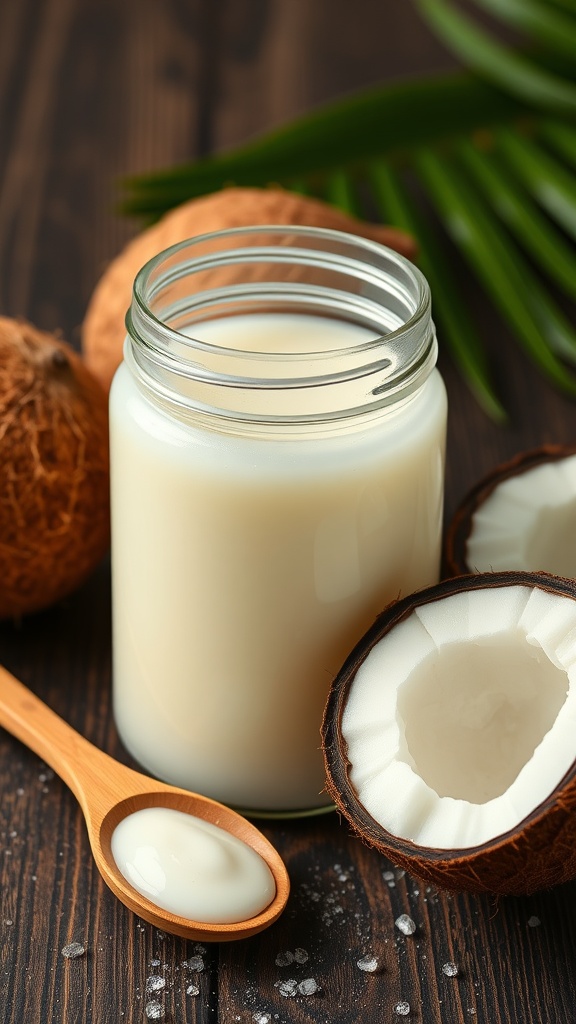
Coconut oil is a fantastic option for those looking to incorporate anti inflammation foods into their diet. It’s rich in medium-chain triglycerides (MCTs), which can help reduce chronic inflammation in the body. Using coconut oil in your cooking not only adds a delightful flavor but also provides health benefits.
This photo showcases a jar of coconut oil alongside a halved coconut. The natural beauty of the coconut and the creamy texture of the oil make it a perfect fit for clean eating. You can use it in easy low fodmap recipes, making it ideal for those following a low fodmap diet.
Consider adding coconut oil to your anti inflammation meal plan. It works great for sautéing veggies or in smoothies for an anti inflammation breakfast. Plus, it can be used in low fodmap snacks or even in baking. Just remember to check the low fodmap food list to ensure you’re staying within guidelines.
When you’re cooking with coconut oil, you’re choosing a non inflammatory food that aligns well with an inflammation diet for beginners. It supports healthy digestion, which is key for anyone managing IBS. So, whip up some healthy lunch recipes or low fodmap lunch ideas using coconut oil and enjoy the benefits!
Apples for Fiber and Antioxidants
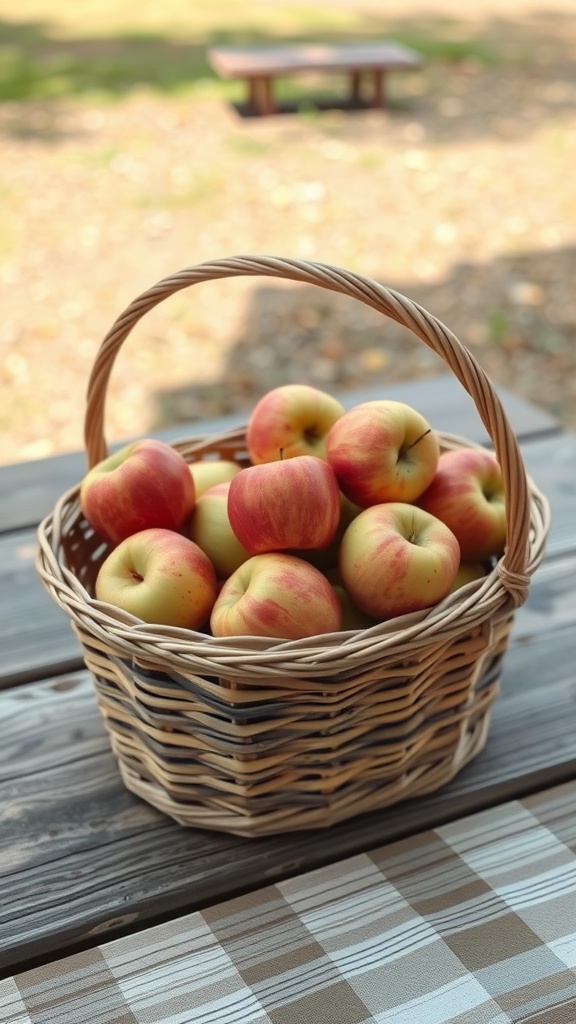
Apples are a fantastic addition to your diet, especially for those managing endometriosis. They are packed with fiber, which is essential for digestive health. Fiber helps to keep everything moving smoothly in your gut and can even aid in reducing inflammation.
In the image, you can see a lovely basket of apples, showcasing their vibrant colors and fresh appeal. Incorporating apples into your meals can be as easy as slicing them up for a snack or adding them to salads and smoothies. They fit perfectly into a low FODMAP meal plan, making them a great option for anyone on the low FODMAP diet.
Besides fiber, apples are loaded with antioxidants. These compounds play a significant role in fighting chronic inflammation. The more antioxidants you consume, the better you can support your body in its fight against inflammation.
For easy low FODMAP recipes, try baking apples with a sprinkle of cinnamon for a delicious anti-inflammatory dessert. You can also mix diced apples into your morning oatmeal for a nutritious anti inflammation breakfast. Apples are truly versatile and can fit into many healthy lunch recipes or low FODMAP snacks.
Quinoa for Complete Protein
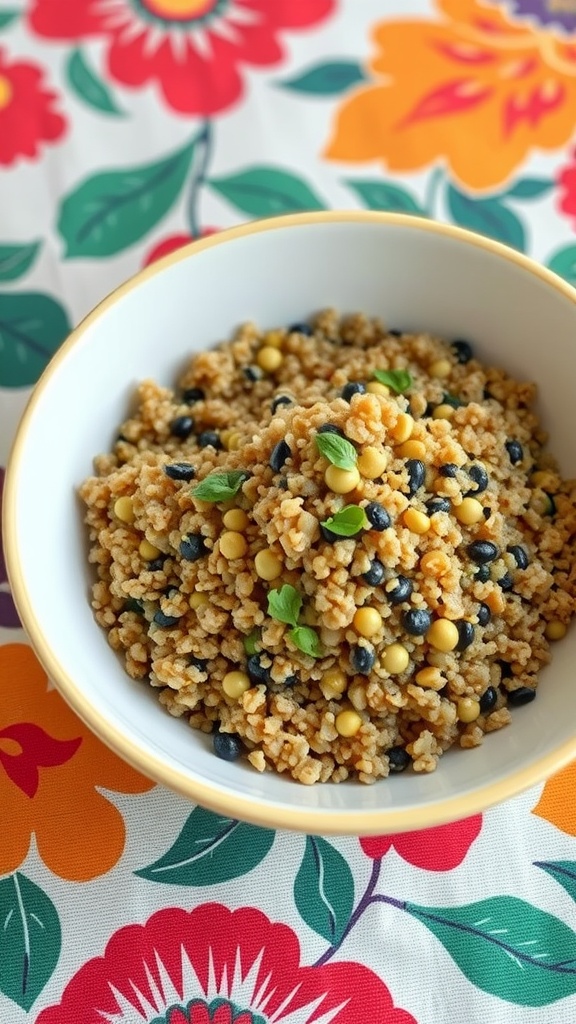
Quinoa is a superstar in the world of grains, especially for those dealing with endometriosis. This bowl of fluffy quinoa, speckled with black beans and chickpeas, is not just colorful but also packed with nutrients.
One of the best things about quinoa is that it’s a complete protein. This means it contains all nine essential amino acids that our bodies can’t produce on their own. When you’re following an anti inflammation diet, including foods like quinoa can really make a difference. It’s a fantastic option for easy low fodmap recipes and healthy lunch recipes.
For a quick meal, you can toss quinoa with veggies and your favorite seasonings. It fits perfectly into an inflammation diet for beginners, providing a nutritious base for many antiinflammatory meals. If you’re looking to reduce inflammation fast, quinoa makes a great addition to your anti inflammation meal plan.
Not only does quinoa help with inflammation, but it’s also IBS-friendly, making it a safe choice for those following a low fodmap diet. Pair it with low fodmap vegetables for a balanced meal. So, next time you think about clean eating, consider adding quinoa to your plate!
Pumpkin Seeds for Nutrients
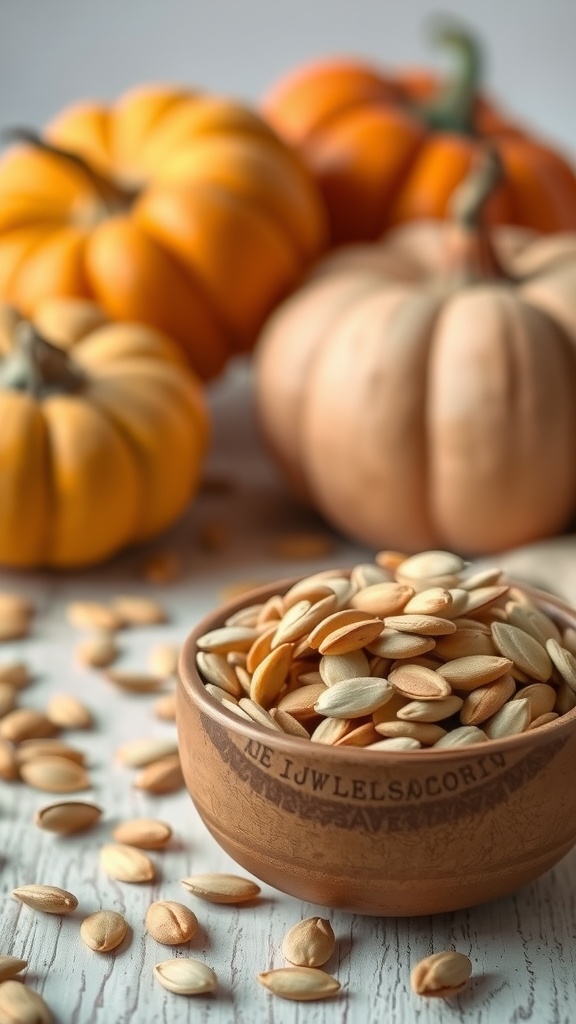
Pumpkin seeds are tiny powerhouses packed with nutrients. They sit comfortably in a beautiful bowl, surrounded by vibrant pumpkins that hint at their seasonal freshness.
These seeds are a fantastic addition to your inflammation diet for beginners. They are loaded with magnesium, zinc, and healthy fats, making them non-inflammatory foods that can contribute to overall wellness.
You can sprinkle them on salads or mix them into smoothies for an easy boost. They also shine in anti inflammation breakfast recipes, adding a nice crunch to your morning routine.
When planning healthy lunch recipes, consider adding pumpkin seeds for an extra nutrient kick. They fit perfectly into anti inflammation meal plans, helping to reduce inflammation fast and support your health.
Whether you’re creating low FODMAP lunch ideas or simply looking for anti inflammation snacks, pumpkin seeds are a versatile option that keeps you satisfied and nourished.
Whole Grains for Balanced Energy
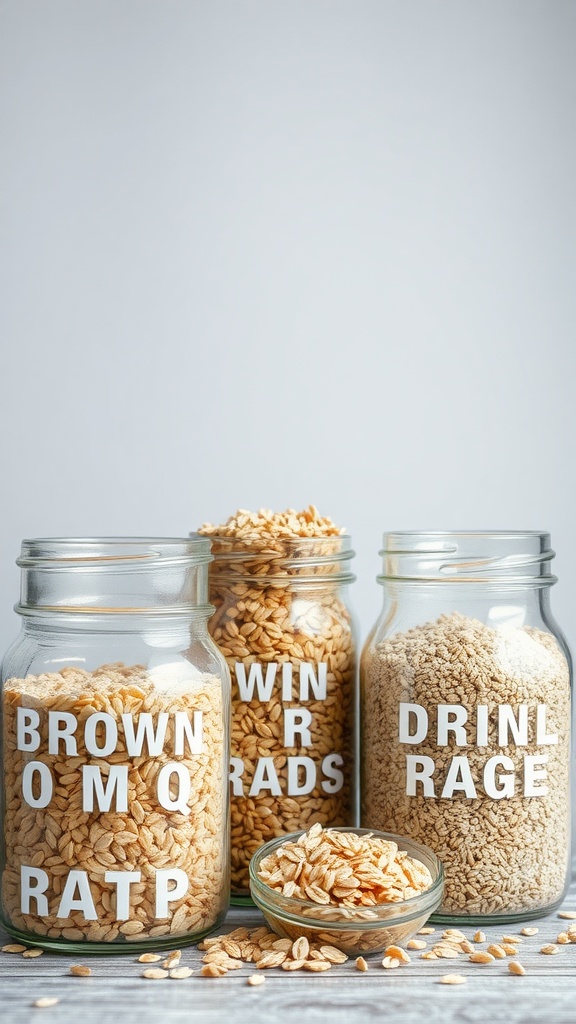
Whole grains are a fantastic source of energy and can be your go-to for a balanced diet. The image shows jars filled with different types of grains, clearly labeled for easy identification. This setup not only looks neat but also serves as a reminder of the variety of grains available for your meals.
Including whole grains in your diet can help combat chronic inflammation, making them a key addition to any anti inflammation meal plan. They provide complex carbohydrates, which release energy slowly, keeping you fueled throughout the day. Foods like brown rice, quinoa, and oats are excellent choices.
If you’re following a low FODMAP diet, you can enjoy grains like rice and quinoa without worry. They fit perfectly into low FODMAP meal prep, helping you create delicious and satisfying meals. Try incorporating these grains into your antiinflammatory recipes to create tasty, healthy lunch recipes.
Don’t forget, grains can also be used for anti inflammation snacks! Think about making some easy low FODMAP recipes like rice cakes topped with nut butter or quinoa salads. These snacks not only taste great but also support your overall wellness.
Red Grapes for Resveratrol
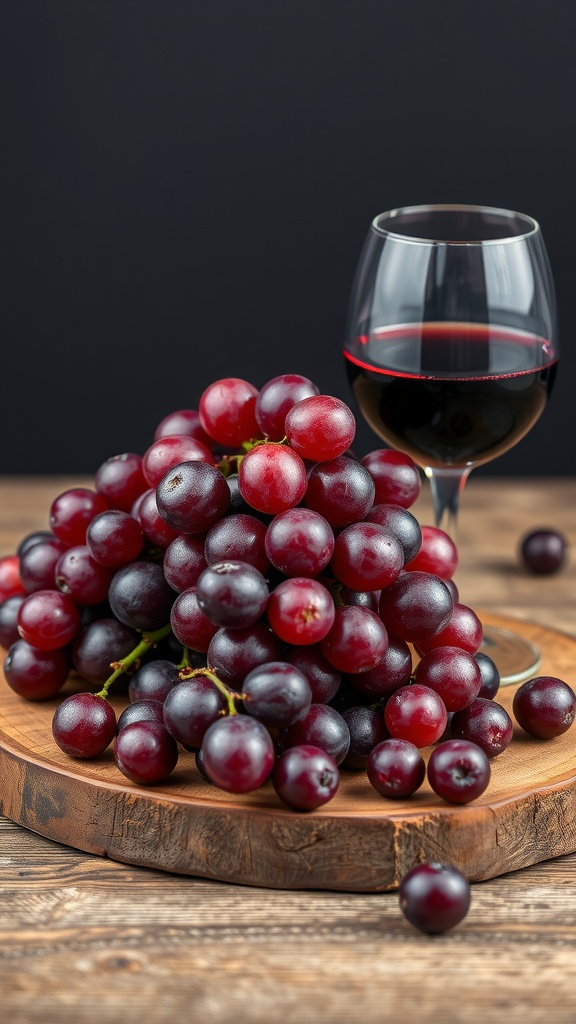
Red grapes are not just a tasty snack; they are packed with health benefits. They contain resveratrol, a powerful antioxidant that helps reduce inflammation. This can be especially beneficial for those dealing with chronic inflammation and conditions like endometriosis.
In the image, we see a beautiful bunch of red grapes alongside a glass of red wine. The deep colors of the grapes hint at their rich nutrient content. Including these in your diet is easy, whether you eat them fresh or enjoy them in your favorite anti inflammation recipes meals.
For those on a low fodmap diet, red grapes are a great choice. They are IBS-friendly and can fit into your low fodmap meal plan without worry. You can throw them in salads or enjoy them as an anti inflammation snack. They also work well in healthy lunch recipes or even as a sweet addition to low fodmap recipes breakfast.
Try adding red grapes to your anti inflammation food list. They can help you on your journey towards cleaner eating and reducing inflammation fast.
Cabbage for High Fiber Content
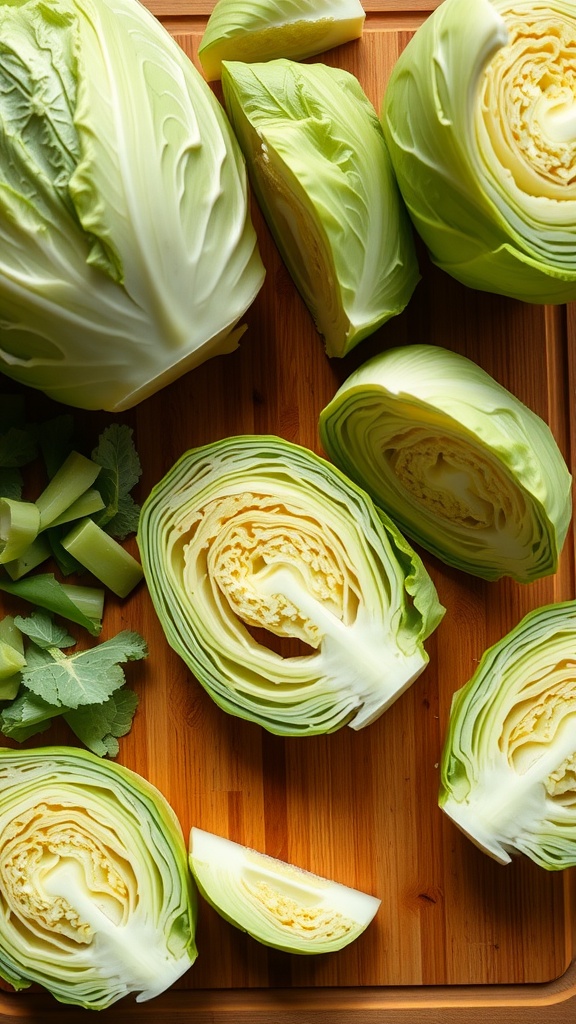
Cabbage is a fantastic vegetable to include in your meals, especially when looking to manage inflammation. Its high fiber content makes it a star in the fight against chronic inflammation. Fiber helps support a healthy digestive system, which is crucial for anyone dealing with conditions like endometriosis.
This image showcases fresh, crisp cabbage, cut into sections, revealing its tightly packed leaves. The vibrant green color signals its nutritional value. Cabbage can easily fit into various low FODMAP recipes for breakfast, lunch, or dinner. Think cabbage slaws or adding it to stir-fries for a healthy lunch recipe.
If you’re on a low FODMAP diet, cabbage offers low FODMAP lunch ideas or snacks that won’t upset your stomach. Not only does it add crunch to meals, but it also helps reduce inflammation fast. Incorporating cabbage into your anti-inflammation meal plan can be both easy and delicious.
Try adding it to anti-inflammatory meals like cabbage soup or coleslaw. You can also prepare some easy low FODMAP recipes that feature cabbage as the main ingredient. The possibilities are endless, and your body will thank you for it!
Kefir for Probiotics
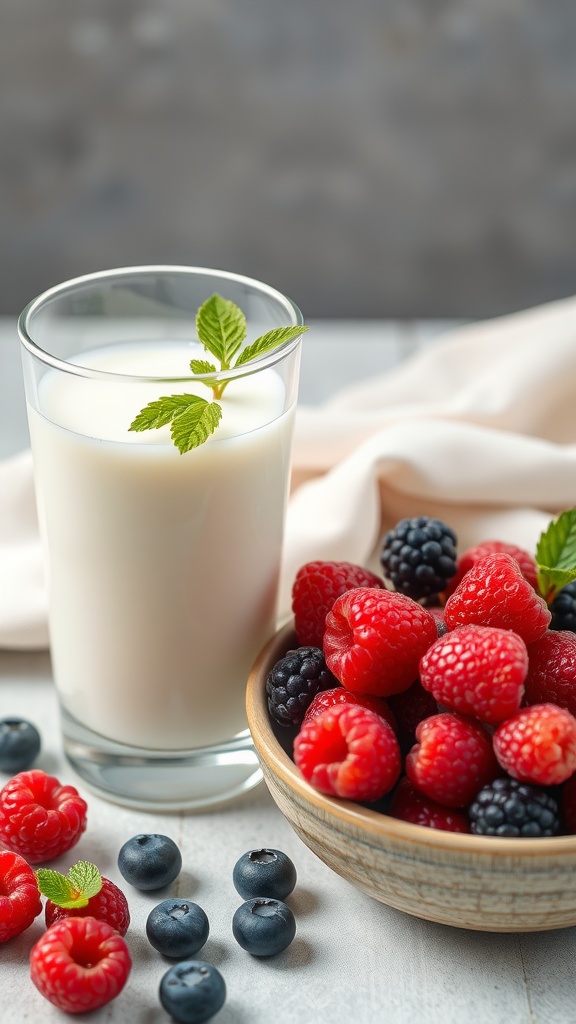
Kefir is a delicious fermented drink packed with probiotics. It’s made from milk and has a creamy texture. The image shows a refreshing glass of kefir next to a bowl of vibrant berries. This combination is not only tasty but also beneficial for gut health.
Probiotics are essential for a healthy digestive system. They help balance gut bacteria, which can be particularly supportive for anyone dealing with chronic inflammation. Incorporating kefir into your diet can be part of an anti inflammation meal plan. It’s a great addition to your antiinflammatory meals.
Mixing kefir with berries like raspberries and blueberries boosts its health benefits. These fruits are known for their anti-inflammatory properties, making them perfect companions in your diet. Whether you enjoy kefir on its own or as part of low fodmap recipes, it’s a must-try for those looking to reduce inflammation fast.
Broccoli Sprouts for Nutritional Boost
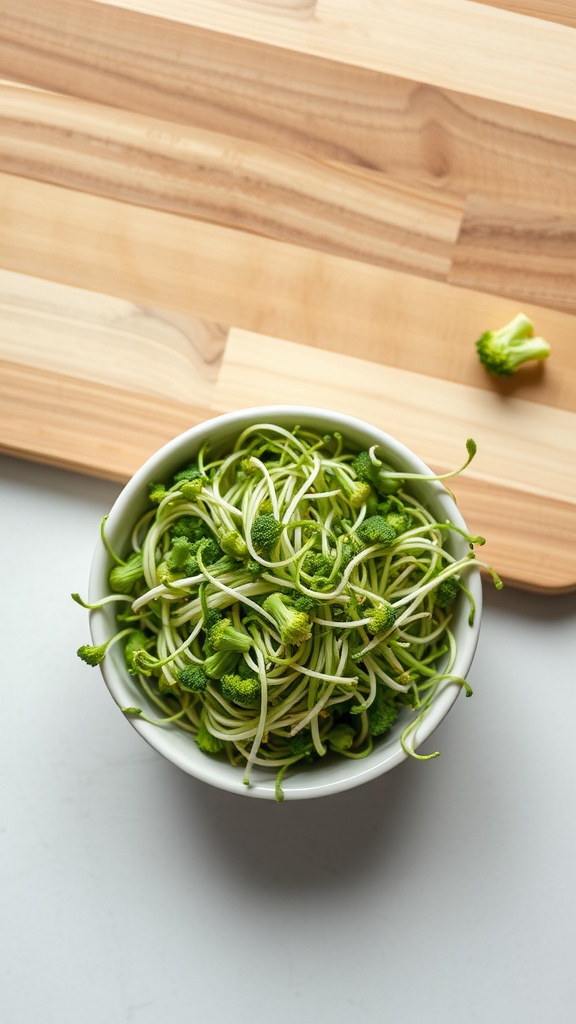
Broccoli sprouts are tiny powerhouses of nutrition, perfect for those looking to add anti inflammation foods to their diet. These little greens are packed with vitamins, minerals, and antioxidants, making them a fantastic choice for anyone managing chronic inflammation.
These sprouts are especially beneficial for a low FODMAP meal plan, as they are low in fermentable carbohydrates. This makes them a great addition to IBS diet food lists, providing a healthy option that won’t upset your stomach.
Using broccoli sprouts in easy low FODMAP recipes is simple. Toss them in salads, blend them into smoothies, or sprinkle them on top of soups for an extra crunch. They can also be included in anti inflammatory meals, helping to reduce inflammation fast.
For a quick and healthy lunch, try incorporating broccoli sprouts into low FODMAP lunch ideas. They pair well with grilled chicken and a light vinaigrette, creating a clean eating option that tastes great and is good for you.
Fermented Soy Products for Nutrients

Fermented soy products, like tofu, are fantastic choices for an anti inflammation meal plan. This image shows perfectly roasted tofu cubes, golden and seasoned to perfection. Tofu is versatile and can fit into various antiinflammatory meals, making it a staple for many who aim to reduce chronic inflammation.
Incorporating tofu into your diet is simple. You can add it to your low fodmap lunch ideas or mix it into a hearty salad. Pair it with fresh veggies and herbs for a burst of flavor. Plus, it’s packed with protein, making it a great option for those looking to maintain muscle health without inflammation.
Tofu can easily be adapted for different tastes. You can marinate it in soy sauce, ginger, or garlic for a savory kick. Try it as an ingredient in your anti inflammation recipes meals or toss it into a stir-fry for a healthy lunch recipe. It’s even a great base for low fodmap recipes breakfast, providing a filling start to your day.
Don’t forget about the health benefits! Fermented soy products are known to be non inflammatory foods, which can help balance the gut and support an IBS-friendly food plan. So, whether you’re looking for anti inflammation snacks or hearty meals, tofu has got you covered.
Miso for Flavor and Probiotics
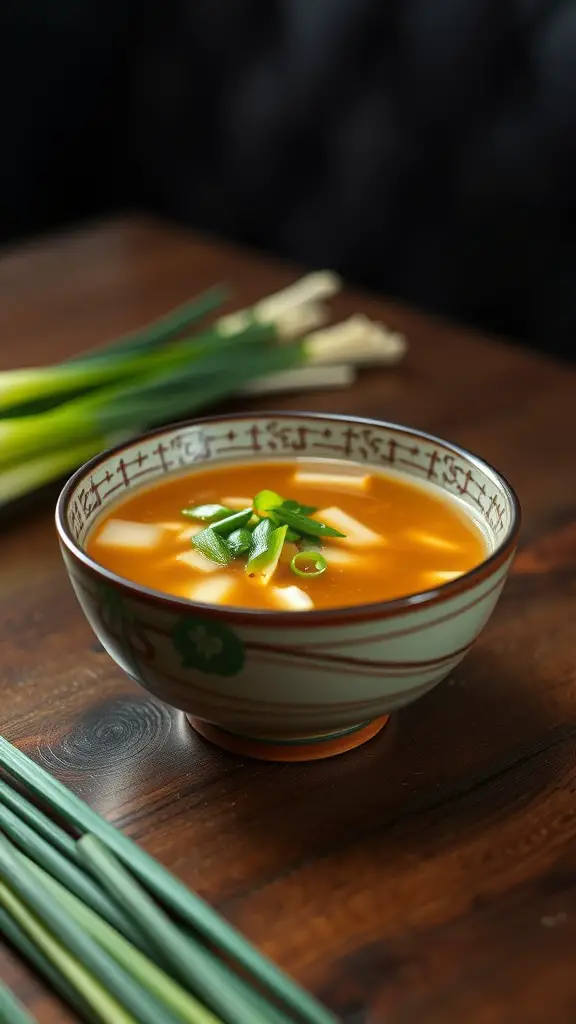
Miso is a fantastic ingredient that can add depth to your meals while also providing health benefits. This fermented soybean paste is not just about flavor; it’s rich in probiotics, which are great for gut health. A healthy gut is essential, especially for those managing chronic inflammation, like endometriosis.
The image shows a warm bowl of miso soup, topped with fresh green onions, inviting you to enjoy a comforting dish. Miso soup can be part of an anti inflammation meal plan. It fits well into a low FODMAP diet, making it suitable for those with IBS.
Using miso in your cooking can lead to easy low FODMAP recipes that are both satisfying and nutritious. You can incorporate miso into dressings, marinades, or even as a base for soups and sauces. It’s versatile and can help create anti inflammation recipes meals that taste great.
For a quick and healthy option, consider making a simple miso soup. Just mix miso paste with hot water, add some tofu, seaweed, and green onions. You’ll have a delicious anti inflammation breakfast or light lunch in no time!
Green Apples for Low Sugar Option
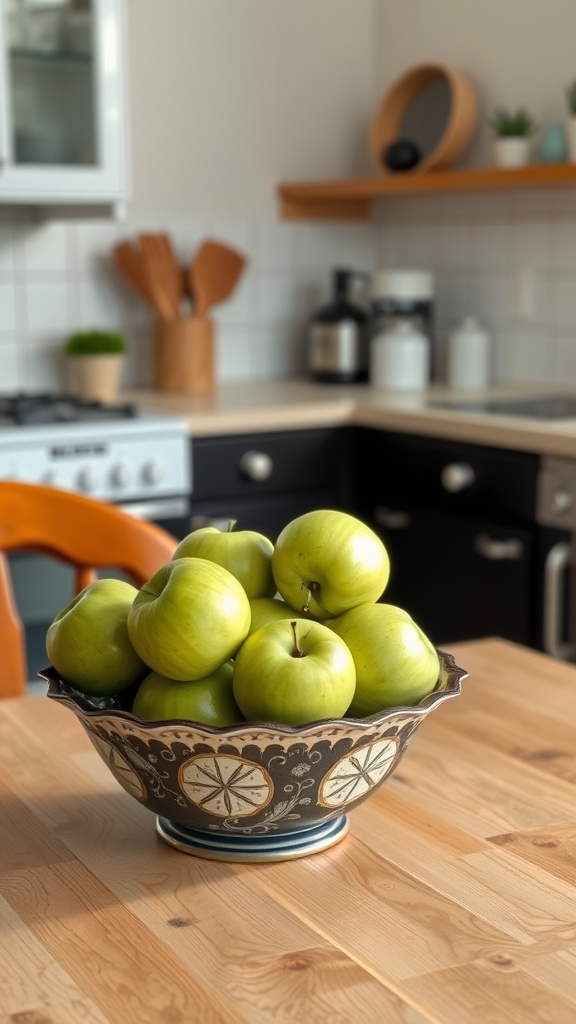
Green apples are a great choice for those seeking a low sugar option in their diet. These apples not only add a crisp, refreshing taste but are also packed with nutrients. Their tart flavor makes them a favorite for clean eating and anti-inflammatory recipes.
Incorporating green apples into an inflammation diet can be beneficial. They contain antioxidants and fiber, which help combat chronic inflammation. This makes them a great addition to any healthy meal plan.
For a quick snack or breakfast, try slicing green apples and pairing them with almond butter. This is an easy low FODMAP recipe that boosts your energy without spiking your sugar levels. You can also toss them in salads or blend them into smoothies for a refreshing drink.
Try adding green apples to your anti inflammation meal prep. They can be included in fruit salads, used in baking, or even cooked into savory dishes. The versatility of green apples truly shines in anti-inflammatory meals.
Hemp Seeds for Protein and Omega-3
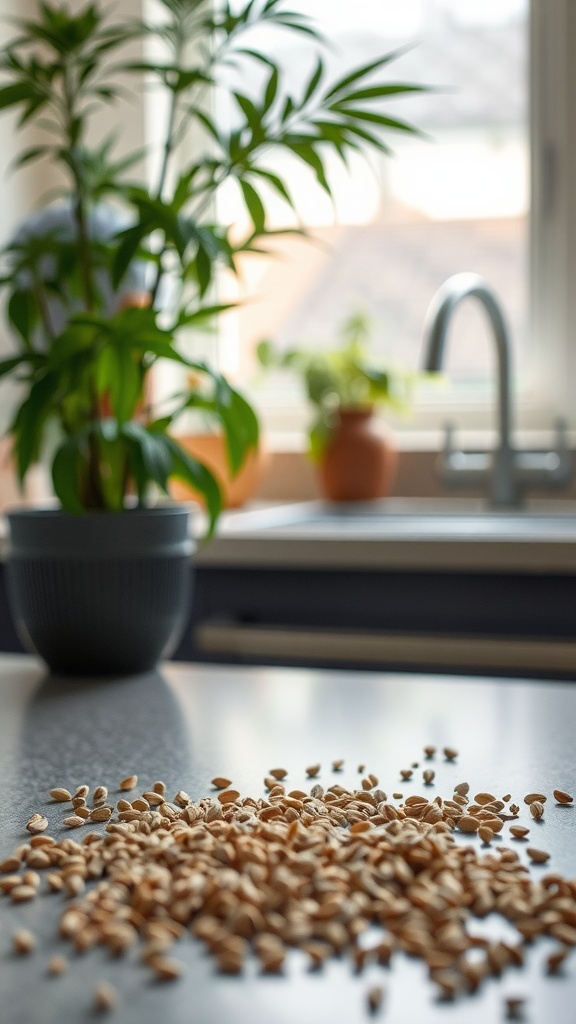
Hemp seeds are small but mighty when it comes to nutrition. They are packed with protein, making them a great addition to any meal, especially for those following a low FODMAP diet. Just a handful can contribute significantly to your daily protein intake, which is essential for maintaining muscle and overall health.
These little seeds are also rich in omega-3 fatty acids, which are known for their anti-inflammatory properties. Incorporating hemp seeds into your meals can be a simple way to support your inflammation diet for beginners. They can help reduce chronic inflammation, making them an excellent choice for anyone dealing with conditions like endometriosis.
The image shows hemp seeds scattered on a kitchen counter, surrounded by vibrant greenery. This setting highlights how easy it is to include these seeds in your daily routine. You can sprinkle them on salads, blend them into smoothies, or even mix them into your anti-inflammatory breakfast recipes.
For those looking for easy low FODMAP recipes, consider adding hemp seeds to your healthy lunch recipes or using them as a topping for low FODMAP snacks. They not only enhance the nutritional value but also add a nice crunch. So, when planning your anti inflammation meal plan, don’t forget about these nutrient-packed seeds!
Carrots for Beta-Carotene
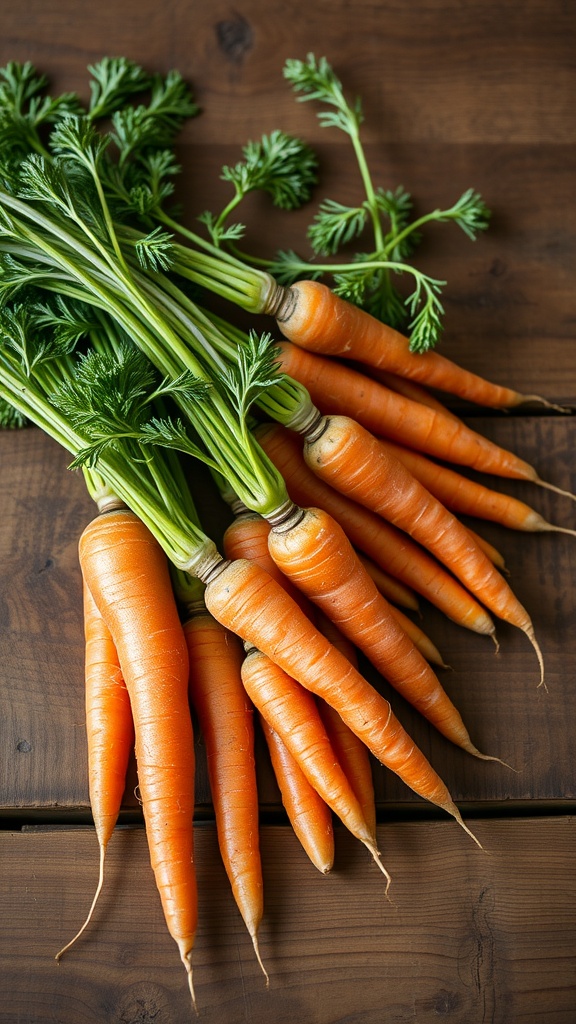
Carrots are a vibrant addition to any meal, especially for those managing endometriosis. These bright orange veggies are loaded with beta-carotene, which the body converts into vitamin A. Vitamin A is essential for maintaining a healthy immune system and can help combat chronic inflammation.
Including carrots in your diet is easy! They make great low FODMAP snacks and can be incorporated into various anti-inflammation recipes. Try them raw in a salad, roasted as a side dish, or blended into a smooth soup. Whether you’re looking for healthy lunch recipes or anti-inflammation breakfast ideas, carrots fit right in.
For a simple carrot dish, just peel and chop them, toss with olive oil, salt, and herbs, and roast until tender. This easy low FODMAP recipe makes a perfect addition to your anti-inflammation meal plan. Plus, they’re IBS-friendly, making them a go-to choice for anyone following a low FODMAP diet.
So, next time you’re planning your meals, consider adding carrots to your shopping list. They not only taste great but also pack a nutritional punch that can help reduce inflammation fast!
Artichokes for Antioxidants
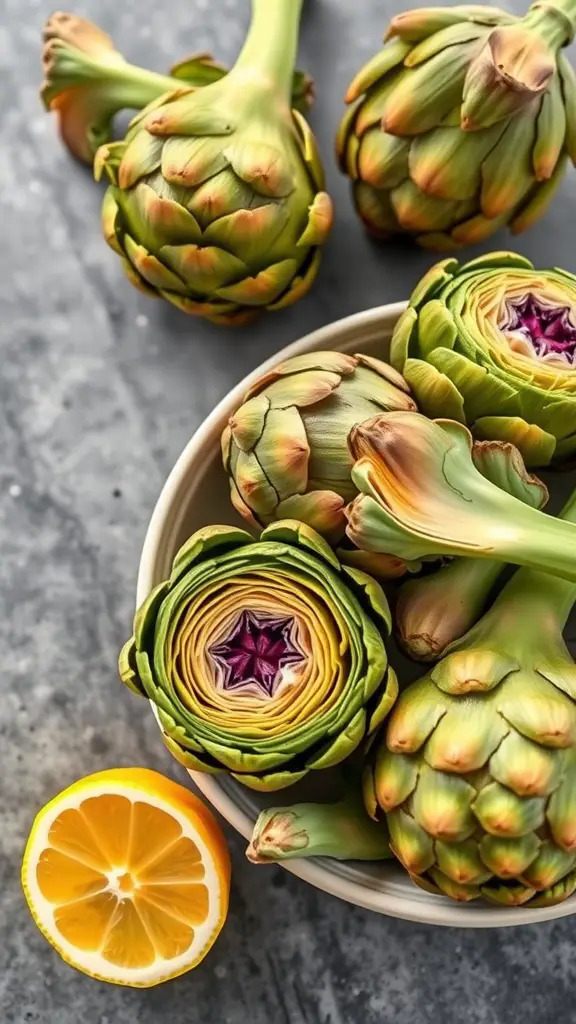
Artichokes are not just tasty; they are also packed with antioxidants that can help fight inflammation. The vibrant green and purple hues of the artichokes in the image show their freshness and appeal. They can be a colorful addition to your meals, making them not only healthy but also visually appealing.
Including artichokes in your diet can be a great way to reduce chronic inflammation. Whether you enjoy them steamed, grilled, or in salads, they offer a variety of anti inflammation benefits. They can fit well into anti inflammation meal plans and can be included in anti inflammation recipes meals.
If you’re looking to start an inflammation diet for beginners, adding artichokes is a smart choice. They are considered non-inflammatory foods, making them suitable for anyone focusing on reducing inflammation fast. Plus, being low in calories, they can fit into healthy lunch recipes or make for great low fodmap snacks.
To prepare artichokes, simply trim the outer leaves, steam or boil them, and serve with a squeeze of lemon juice. This quick and easy method maintains their nutritional value while enhancing their flavor. For those on a low fodmap diet, artichokes are a fantastic option, giving you an IBS-friendly food that can be enjoyed without worry.
Nut Butters for Healthy Spreads
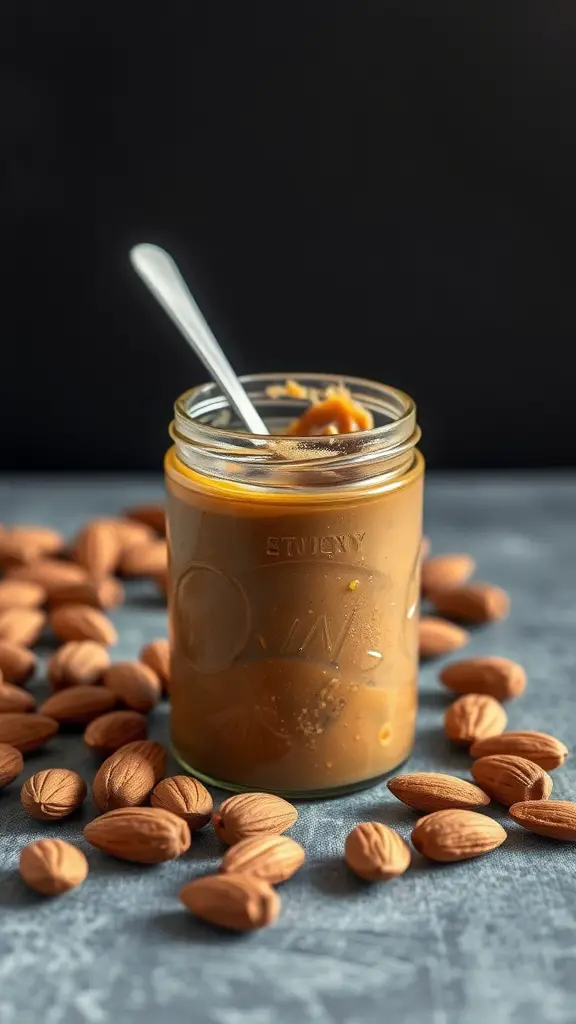
Nut butters are not just tasty; they pack a punch of nutrition that can help with inflammation. This image shows a jar of almond butter surrounded by whole almonds. Almond butter is creamy, delicious, and a great choice for those following an anti-inflammation diet. It’s a perfect addition to your healthy lunch recipes or a quick snack.
When you’re dealing with chronic inflammation, incorporating non-inflammatory foods into your meals can make a difference. Nut butters like almond or cashew provide healthy fats and protein. They’re also low FODMAP friendly, making them suitable for those on an IBS diet. Try spreading some on rice cakes or adding a scoop to your smoothies for a boost!
Creating easy low FODMAP recipes with nut butters is simple. You can mix almond butter with banana for a quick anti-inflammatory breakfast or blend it into your anti-inflammation meal plan. The rich flavor and creamy texture make it a delightful and nutritious choice.
Lentils for Rich Protein Source
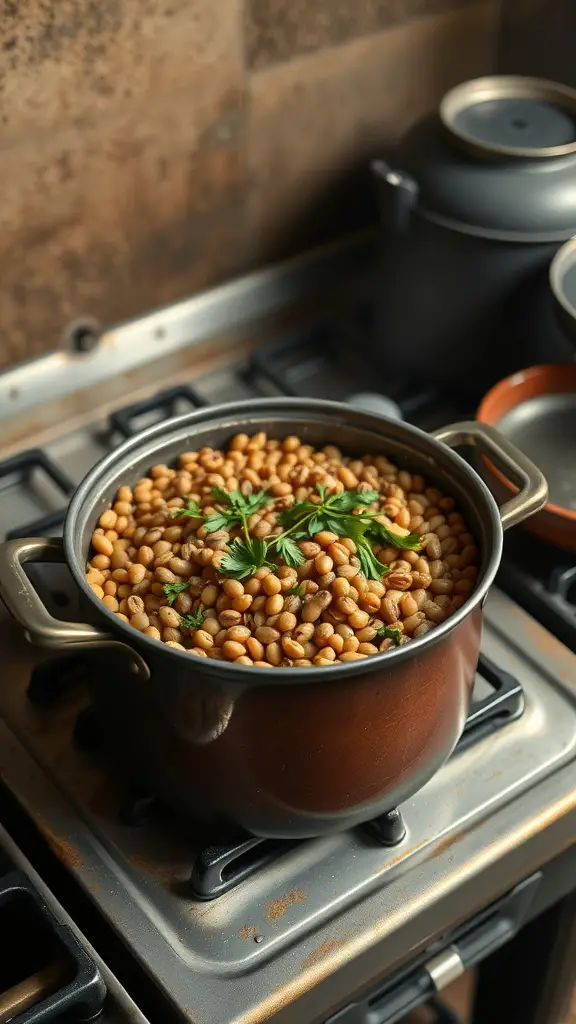
Lentils are a fantastic addition to your meals, especially for those looking to manage inflammation. This image shows a pot of cooked lentils, which are not only packed with protein but also rich in fiber and nutrients.
When it comes to anti inflammation foods, lentils shine as a top choice. They are versatile and can easily fit into an inflammation diet for beginners. You can enjoy them in soups, salads, or even as a side dish. Plus, they make for great anti inflammation snacks when mixed with herbs and spices.
These legumes help reduce chronic inflammation, making them a key component in an anti inflammation meal plan. If you’re on a low FODMAP diet, lentils can still be enjoyed in moderation. Just make sure to choose the right types and portion sizes.
For easy low FODMAP recipes, try preparing a lentil salad with low FODMAP vegetables like cucumbers and carrots. Toss in a light dressing, and you’ll have a healthy lunch option that’s both tasty and satisfying!
Pomegranate for Antioxidant Boost
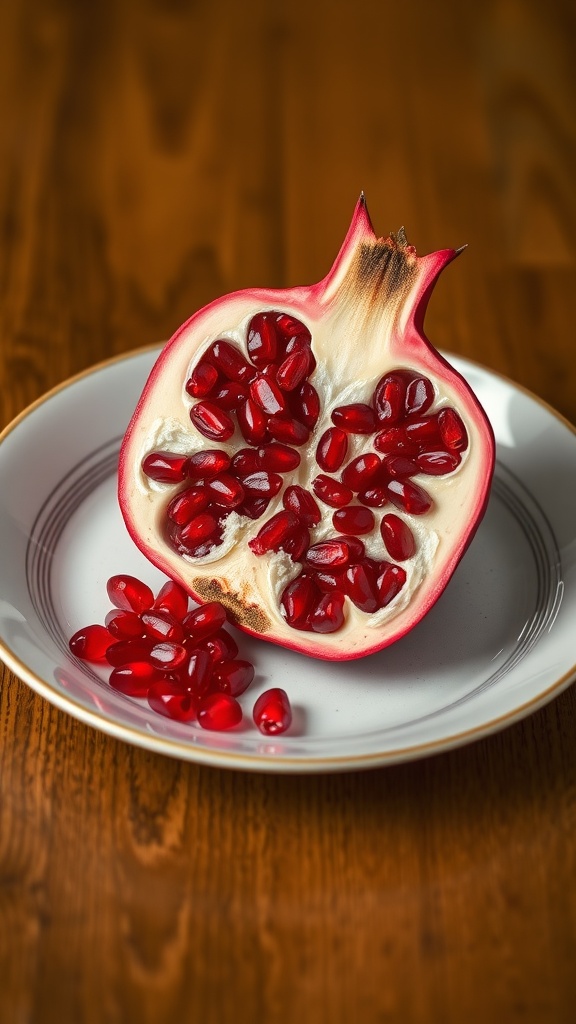
Pomegranate is a fantastic fruit that really shines when it comes to fighting inflammation. The vibrant red seeds are packed with antioxidants that help combat chronic inflammation, making it a great addition to an anti inflammation diet.
In the image, you can see a beautifully cut pomegranate showcasing its juicy seeds. These little gems not only look stunning but are also delicious and versatile. You can toss them into salads, add them to smoothies, or enjoy them as a snack. Incorporating pomegranate into your meals is an easy way to boost your nutrition.
For those following an inflammation diet for beginners, pomegranate fits perfectly into your anti inflammation meal plan. It’s considered a non inflammatory food and can be enjoyed in various forms, whether fresh, juiced, or even as a powdered supplement.
Plus, it’s IBS friendly, making it a great choice for anyone looking to reduce inflammation fast while also managing digestive health. So, don’t hesitate to include this superfood in your anti inflammation recipes meals!
Sweet Peppers for Color and Flavor

Sweet peppers are not only vibrant and colorful but also packed with nutrients. They come in a variety of colors, including green, red, yellow, and orange. Each color offers unique health benefits, making them a great addition to your meals.
Including sweet peppers in your diet can help reduce inflammation. They are low in calories and rich in vitamins A and C, which are known to support the immune system. These vitamins play a role in fighting chronic inflammation, making sweet peppers a smart choice for anyone looking to manage their health.
For those following a low FODMAP diet, sweet peppers are a friendly option. They can easily fit into your meal plan, whether you’re making a salad or adding them to your stir-fry. Try including them in your healthy lunch recipes or as a colorful side dish.
Need some ideas? Toss sweet peppers into your anti-inflammatory meals, or use them as a crunchy, low FODMAP snack. They can be sliced and enjoyed with hummus or added to an anti-inflammatory breakfast omelet for a burst of flavor.
Rhubarb for Vitamin K
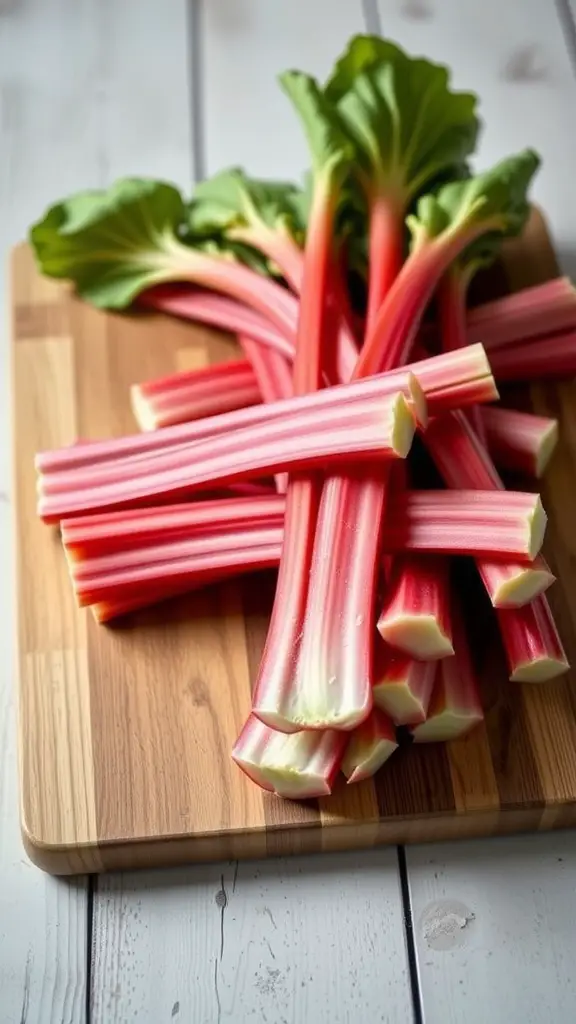
Rhubarb is not just a pretty face; it’s packed with Vitamin K, which plays a vital role in blood health and bone strength. This vibrant, tart vegetable can add a unique twist to your anti-inflammatory meals. You might be surprised at how versatile it is!
The image showcases fresh rhubarb stalks, with their striking pink and green hues. This colorful vegetable can be used in various recipes, from jams to savory dishes. Incorporating rhubarb into your meals can help boost your intake of non-inflammatory foods.
If you’re following an inflammation diet for beginners or looking for low FODMAP snacks, rhubarb can fit right in. You can whip up easy low FODMAP recipes that include rhubarb. Think of desserts, smoothies, or even savory dishes that can benefit from its tangy flavor.
For a refreshing anti-inflammation breakfast, try adding cooked rhubarb to oatmeal or yogurt. You can also explore anti-inflammation recipes meals that feature this dynamic ingredient. With rhubarb in your pantry, you’re one step closer to reducing inflammation fast!
Cabbage for Versatile Cooking
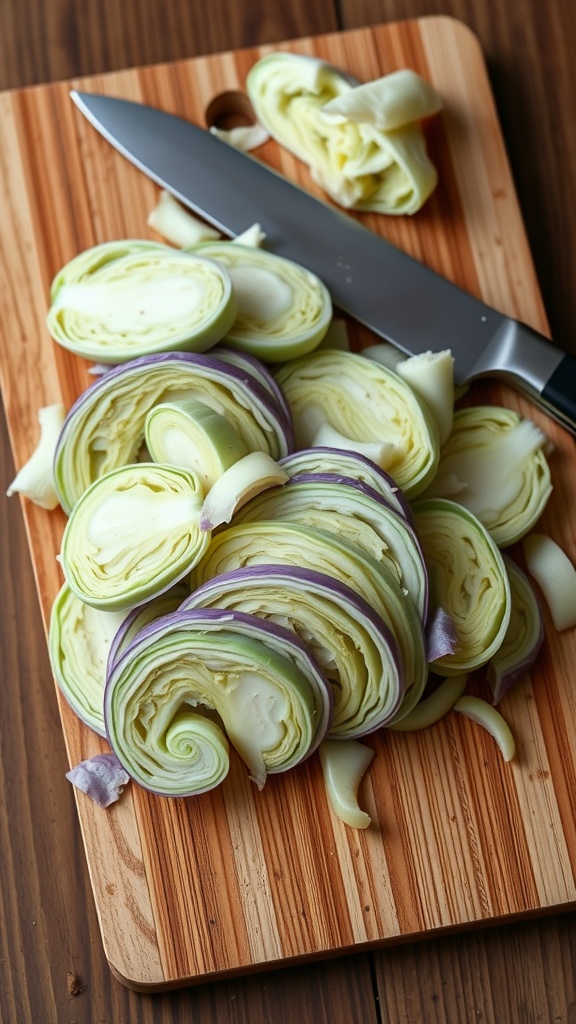
Cabbage is a fantastic addition to your meal plan, especially if you’re looking for foods that help with inflammation. Its vibrant green and purple layers can brighten up any dish. Plus, it’s a low FODMAP vegetable, making it great for those on a low FODMAP diet.
In the image, you see thinly sliced cabbage, perfectly prepared for cooking. This versatile veggie can be used in salads, stir-fries, or even as a wrap. If you’re looking for anti inflammation foods, cabbage should definitely be on your list.
Try incorporating cabbage into your meals with some easy low FODMAP recipes. For a healthy lunch, you might toss it with some grilled chicken and a light vinaigrette. Or, for a quick dinner, sauté it with garlic and ginger for a flavorful side that can reduce inflammation fast.
Don’t forget, cabbage also makes a great base for anti inflammation meal prep. You can create a big batch of coleslaw using a simple vinegar dressing for a refreshing side dish that pairs well with many proteins. It’s easy to store and provides a healthy low FODMAP snack option throughout the week.
Wild Rice for Nutty Flavor
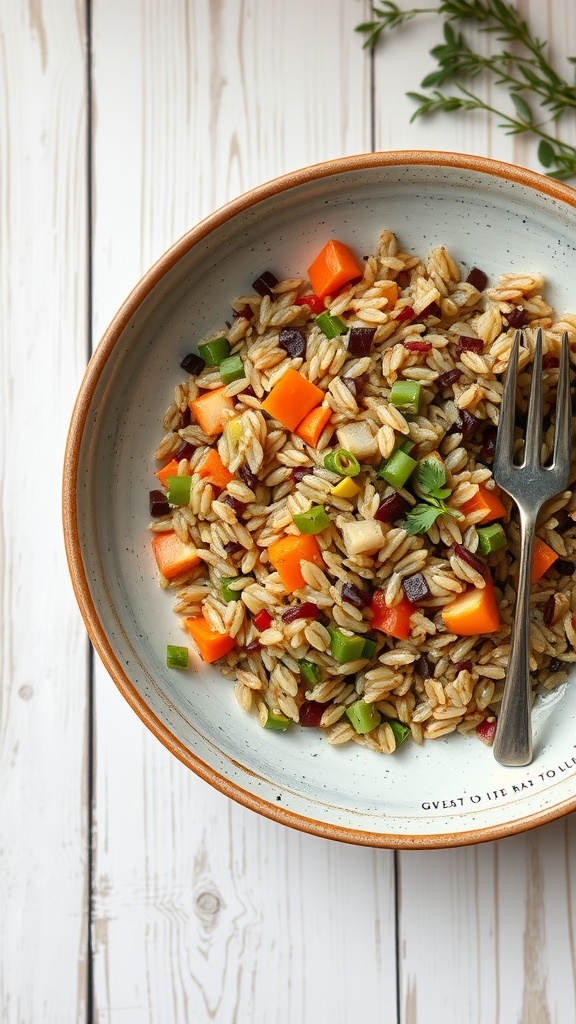
Wild rice isn’t your average grain; it’s a tasty addition that brings a nutty flavor to your meals. It’s packed with nutrients, making it a great choice for anyone looking to reduce inflammation. This colorful dish highlights the grains mixed with vibrant vegetables.
Incorporating wild rice into your diet can fit well with anti inflammation meals. Try it in a salad or as a side dish. It offers a unique taste that complements many low fodmap recipes breakfast or healthy lunch recipes.
As you experiment with different anti inflammation recipes meals, consider wild rice as your go-to grain. It’s not only delicious but also a part of a balanced inflammation diet for beginners. So, if you’re looking for non inflammatory foods, don’t forget to stock up on wild rice!
Squash for Nutrient Variety
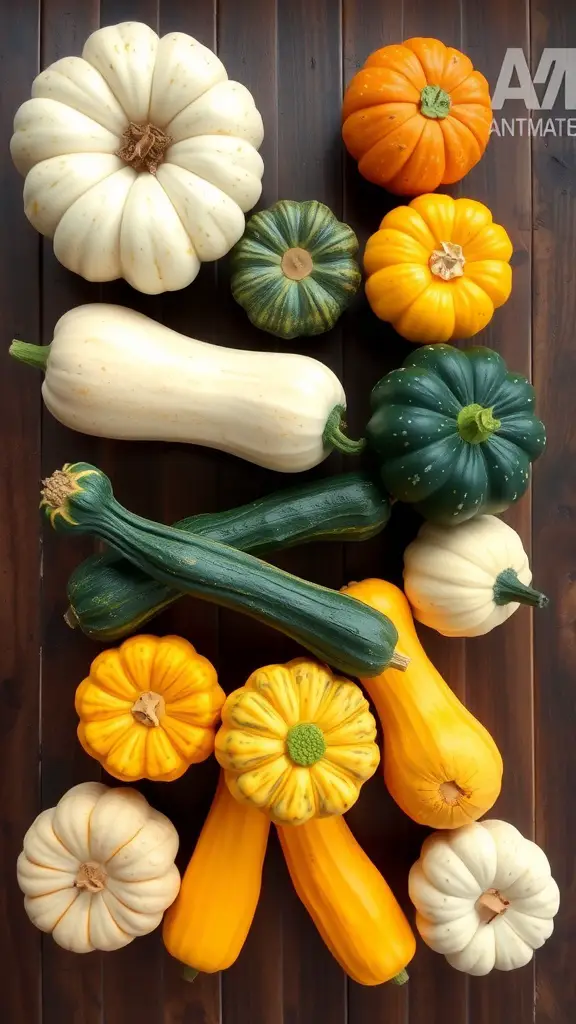
Squash is a fantastic addition to any anti inflammation meal plan. The image shows a colorful array of squash varieties, from the classic butternut to vibrant zucchinis. Each type brings unique nutrients that can help reduce inflammation in the body.
Incorporating squash into your meals is easy. You can roast them, add them to soups, or even use them in low FODMAP recipes for breakfast. They are flexible, making them suitable for quick low FODMAP easy meals or healthy lunch recipes.
Squash is generally low in calories while being packed with vitamins and antioxidants. This makes them ideal ingredients for anti inflammatory food lists. They’re also great for those following an IBS diet food list, as they are gentle on the stomach.
Try making a simple squash soup with garlic and ginger, both known for their antiinflammatory properties. Or consider using squash in easy low FODMAP recipes like stir-fries. Versatile and nutritious, squash can easily fit into your low FODMAP meal prep.
For snacks, roasted squash seeds make a crunchy, satisfying option. They’re not only tasty but also fall under non inflammatory foods. You might even enjoy a squash salad topped with nuts for some added texture and nutrients.
Sardines for Omega-3 Richness
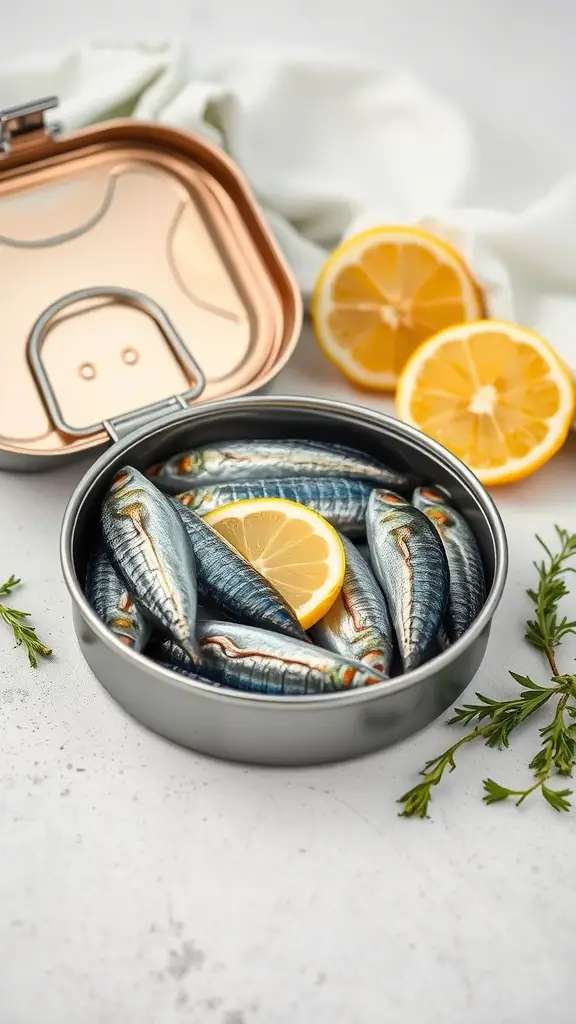
Sardines are a fantastic choice for anyone looking to include anti-inflammation foods in their diet. These little fish pack a powerful punch of omega-3 fatty acids, which are known for their ability to help reduce inflammation fast. Not only are they delicious, but they are also versatile.
The image shows sardines perfectly tucked in a can, surrounded by vibrant lemon slices. The lemon adds a refreshing twist that complements the rich flavor of sardines. Pairing omega-3 rich sardines with low FODMAP vegetables can create an ideal meal for those following a FODMAP diet for beginners.
Incorporating sardines into your anti-inflammation meal plan can be simple. You can toss them into salads, mix them with whole grains, or even enjoy them on whole grain toast for an anti-inflammation breakfast. Easy low FODMAP recipes could include a sardine salad with avocado, lemon juice, and mixed greens. This not only makes for a healthy lunch but also fits perfectly into a clean eating routine.
So, if you’re looking for low FODMAP meal prep ideas, consider adding sardines to your list. They are not just a tasty addition; they’re also a great source of non-inflammatory foods that support your overall health.
Cacao Nibs for Dark Chocolate Flavor
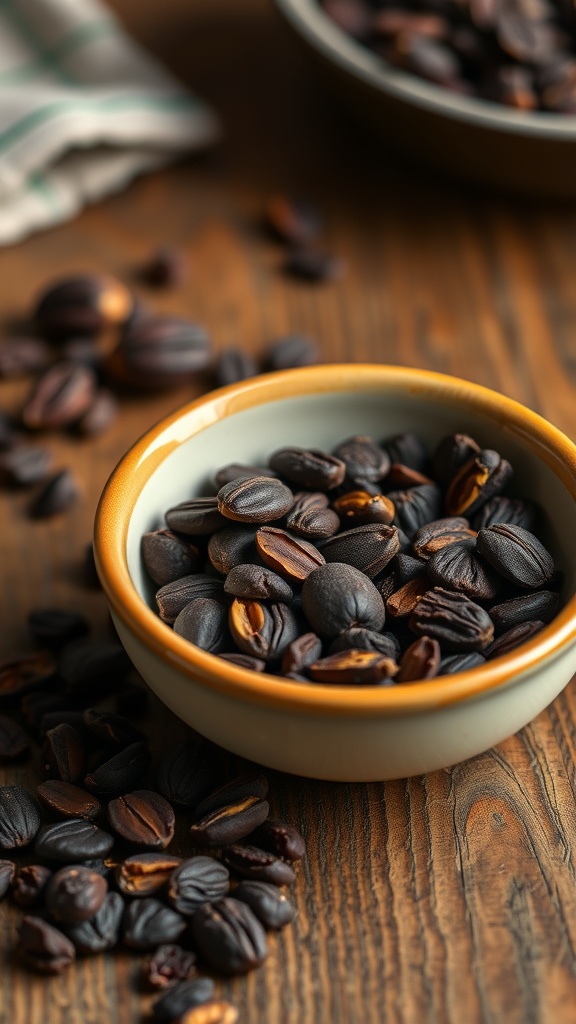
Cacao nibs are a fantastic way to enjoy the rich flavor of dark chocolate while adding health benefits to your meals. These little bits are actually crushed cacao beans, packed with antioxidants and nutrients. They deliver a delightful crunch and a deep chocolate taste that can elevate many dishes.
Incorporating cacao nibs into your diet can be part of an anti inflammation diet. These nibs qualify as non inflammatory foods, making them a great addition to any healthy lunch recipes or snacks. You can sprinkle them on oatmeal, blend them into smoothies, or even add them to low FODMAP meal prep for extra flavor.
If you’re following a low FODMAP diet, cacao nibs are a perfect option. They fit well into easy low FODMAP recipes and can help you whip up delicious anti inflammatory meals. Try mixing them with nuts and seeds for a quick, IBS-friendly food that satisfies your sweet tooth while also being good for you.
Leafy Greens and Their Healing Power
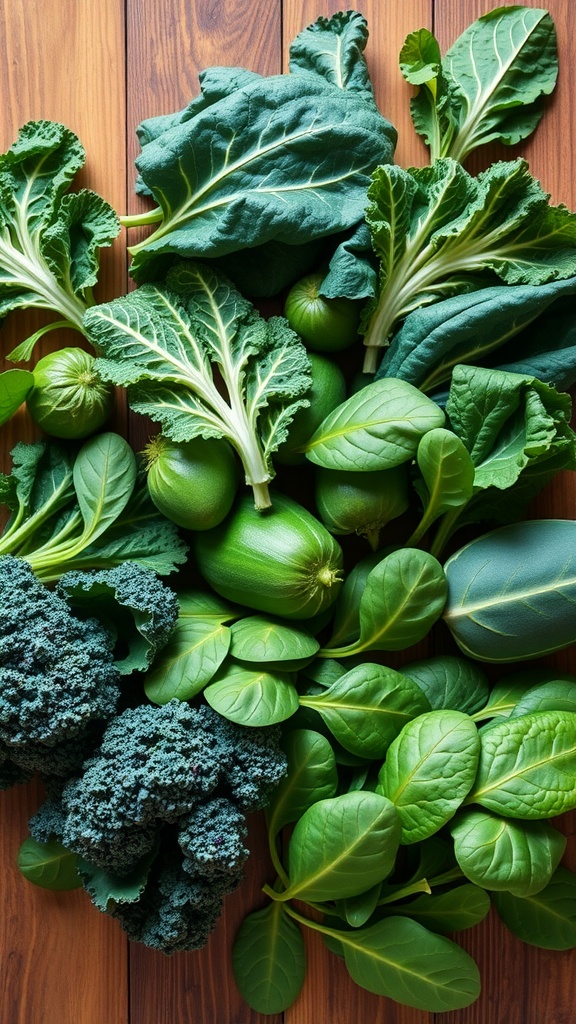
Leafy greens are more than just a pretty addition to your meals; they pack a powerful punch when it comes to fighting inflammation, especially for those dealing with endometriosis. The image showcases a variety of greens like kale, spinach, and collard greens, all rich in vitamins and minerals that support a healthy body.
These greens are known to reduce inflammation fast, making them a fantastic choice for anyone following an inflammation diet for beginners. Incorporating these into your meals can help manage chronic inflammation, which is crucial for those with conditions like endometriosis.
If you’re curious about the low FODMAP diet, many leafy greens fit right in. They are generally easy to digest and can be part of low FODMAP meal prep. Some great options include spinach and Swiss chard. These can easily be included in anti-inflammatory meals or healthy lunch recipes.
Looking for easy low FODMAP recipes? Try sautéing spinach with garlic-infused oil for a tasty side dish! Or toss kale into a smoothie for a quick anti inflammation breakfast. You’ll not only enjoy the flavors but also benefit from their healing properties.
So, when thinking about foods that help with inflammation, remember to stock up on leafy greens. They’re a delicious and nutritious way to combat inflammation while enjoying clean eating habits.
Turmeric and Ginger Benefits
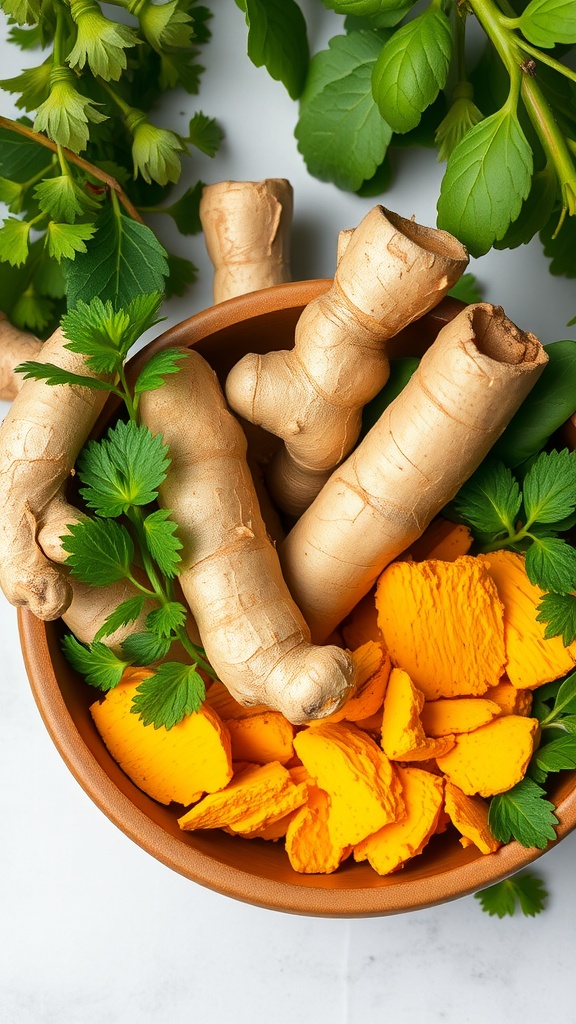
Check out this vibrant image filled with fresh turmeric and ginger. Both of these roots are renowned for their amazing health benefits, especially when it comes to reducing inflammation. The bright orange of the turmeric adds a cheerful touch, while the ginger’s unique shape complements it perfectly. Together, they make a fantastic duo for anyone looking to manage conditions like endometriosis.
Incorporating turmeric and ginger into your meals can be simple and delicious. You can add them to smoothies, soups, or stir-fries. For a quick anti inflammation breakfast, try a warm ginger tea or a turmeric latte. These additions not only enhance flavor but also bring a wealth of health benefits.
When following an anti inflammation diet, these roots shine brightly. Research suggests that turmeric’s active compound, curcumin, works wonders in reducing chronic inflammation. Ginger also has anti-inflammatory properties, making it a friend for those dealing with inflammation-related issues.
If you’re interested in anti inflammation recipes, consider making a turmeric and ginger smoothie. Blend together some almond milk, a banana, a teaspoon of turmeric, and a small piece of ginger for a refreshing start to your day. It’s an easy low FODMAP recipe that anyone can try!
With their bright colors and health benefits, turmeric and ginger can make your meals not only healthier but also more appealing. So, why not add some of these anti inflammatory foods into your daily routine?
Best Anti-Inflammation Foods for Endometriosis
When my wife and I started looking for ways to ease her endometriosis symptoms naturally, we realized that food was either fueling her pain or helping her fight it. The more we researched, the clearer it became—certain anti-inflammation foods have the power to soothe chronic inflammation, balance hormones, and even reduce flare-ups.
Switching to an anti-inflammatory diet wasn’t easy at first. Cutting out processed foods, refined sugars, and dairy felt overwhelming. But once we focused on what she could eat instead of what she couldn’t, things became much more manageable. We discovered a world of delicious, healing foods that not only helped with her endo but also improved her digestion, energy levels, and mood.
Anti-inflammatory foods work by reducing oxidative stress and supporting gut health—two crucial factors in managing endometriosis symptoms. Many women with endo experience IBS-like symptoms, including bloating, constipation, and pain after meals. That’s why an approach that combines anti-inflammatory foods with a low FODMAP diet can be life-changing for some.
Below, we’ll explore the best foods that help fight inflammation and how they support your body in managing endometriosis.
Next, we’ll break down these foods into specific categories to better understand their unique benefits and how they fit into an anti-inflammatory meal plan.
How I Helped My Wife Heal with Anti-Inflammation Foods
I’ll never forget the moment my wife broke down in tears, exhausted from the constant battle with her body. The pain, the bloating, the sleepless nights—it had all become too much. We felt powerless, trapped in an endless cycle of flare-ups and frustration. Doctors gave her painkillers, hormonal treatments, and the usual advice, but nothing truly helped. That’s when we started looking deeper, beyond prescriptions, into something that could genuinely support her healing.
That’s how we found anti-inflammation foods. It wasn’t an overnight fix, but as we gradually shifted her diet, we saw small improvements. Her energy levels stabilized. The endo belly that used to make her look pregnant after every meal? It started to disappear. Her mental clarity improved, and for the first time in years, she felt like she had some control over her own body.
At first, it was daunting. Cutting out processed foods, sugars, and inflammatory ingredients felt like another restriction in a life already filled with limitations. But then we reframed it. Instead of focusing on what she couldn’t eat, we discovered all the amazing, healing foods she could.
We experimented with anti-inflammatory meal plans, incorporating foods that nourished her body instead of punishing it. Omega-3-rich salmon became a weekly staple. Blueberries and walnuts replaced sugary snacks. We added turmeric and ginger to our recipes, and over time, her pain became more manageable.
I won’t say it cured her—because endometriosis doesn’t have a cure. But I will say this: it gave her hope. It gave us hope. Watching my wife go from feeling like a prisoner in her own body to reclaiming her strength was one of the most emotional journeys of my life. And if you or your partner are struggling, I want you to know—you’re not alone, and there is a way forward.
Final Word on Anti-Inflammation Foods
Endometriosis is relentless. It infiltrates every aspect of life, leaving pain, fatigue, and frustration in its wake. But through years of trial and error, my wife and I found that anti-inflammation foods can make a real difference. Not just in reducing pain, but in reclaiming control—one meal at a time.
Inflammation is at the core of endometriosis, fueling painful flare-ups, digestive distress, and emotional exhaustion. By making small, intentional changes to diet, you can help soothe this inflammation and support your body’s healing process. From omega-3-rich fish to antioxidant-packed vegetables, low-FODMAP fruits, and gut-healing fermented foods, every bite has the power to either fight or feed inflammation.
For my wife, the shift toward clean eating wasn’t just about physical relief. It became a way of honoring her body after years of feeling betrayed by it. It wasn’t an easy transition, but with patience and persistence, she saw improvements—less bloating, fewer energy crashes, and a clearer mind. Most importantly, she regained a sense of agency over her own health, something that endometriosis had long stolen from her.
I know this journey can feel isolating. Whether you’re the one battling endo or standing by someone who is, I want you to know that hope exists. Healing is possible, even if it’s not in the way we once imagined. Food won’t cure endometriosis, but it can provide comfort, stability, and relief in a world where so much feels uncertain.
If you or your partner are struggling, I encourage you to take small steps. Try incorporating anti-inflammatory meals into your diet and see how your body responds. Track your symptoms, experiment with what works, and don’t be afraid to ask for support. Because you don’t have to do this alone.
Endometriosis is tough, but you are tougher. Making mindful changes, even small ones, can help you regain some control and find a bit of relief in the chaos. You deserve that.
Let me know in the comments—have you tried an anti-inflammatory diet? What foods have helped you the most? And if you’d like to go deeper into understanding endometriosis and how to support your body, check out the FREE chapter of my book, “Endo-Tool: Endometriosis for Men.” You’ll find personal insights, medical information, and exclusive resources to help you navigate this journey.


About Me
Hi, I’m Lucjan! The reason why I decided to create this blog was my beautiful wife, who experienced a lot of pain in life, but also the lack of information about endometriosis and fibromyalgia for men…
